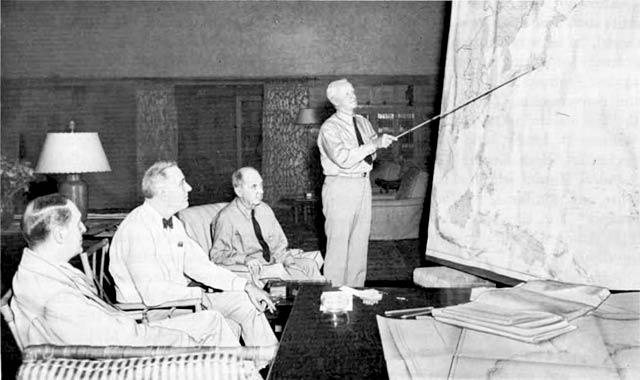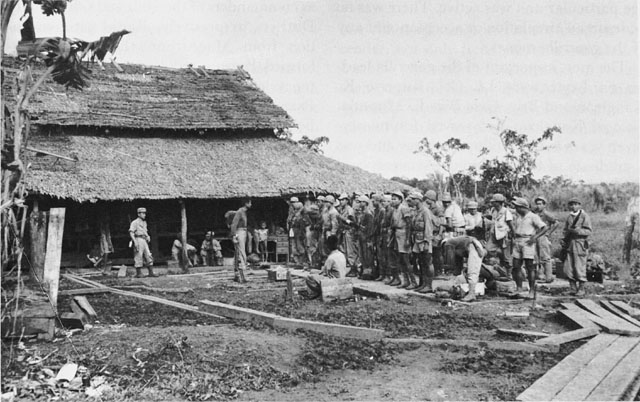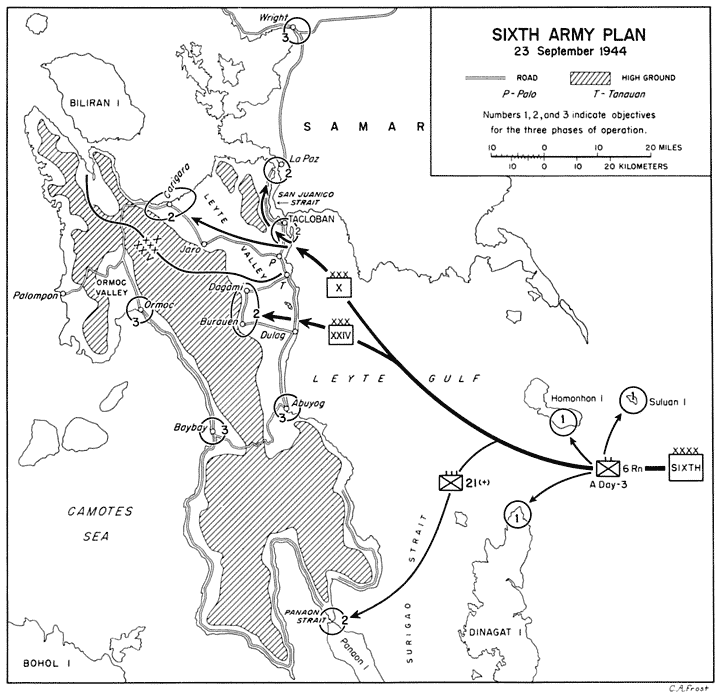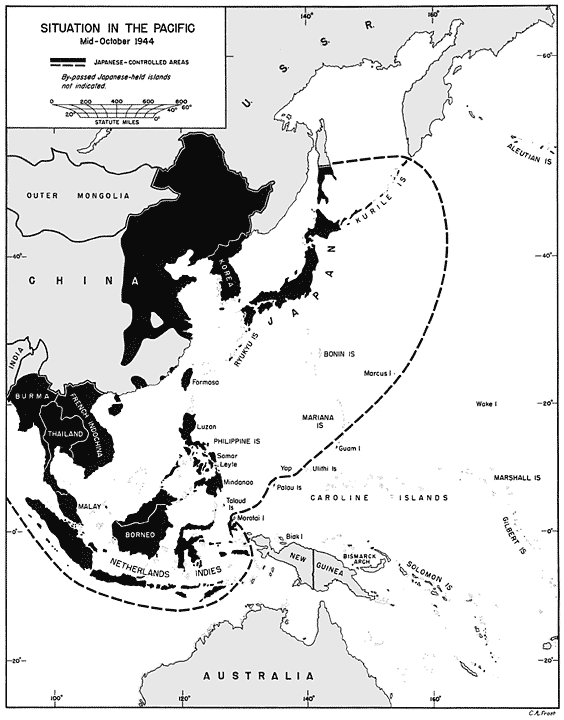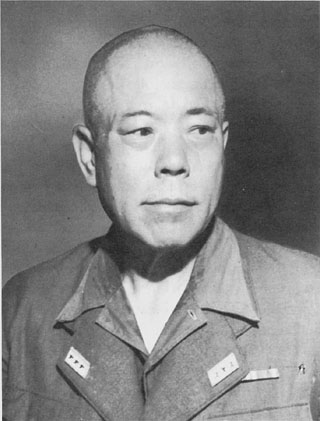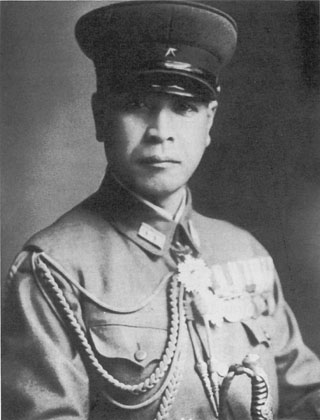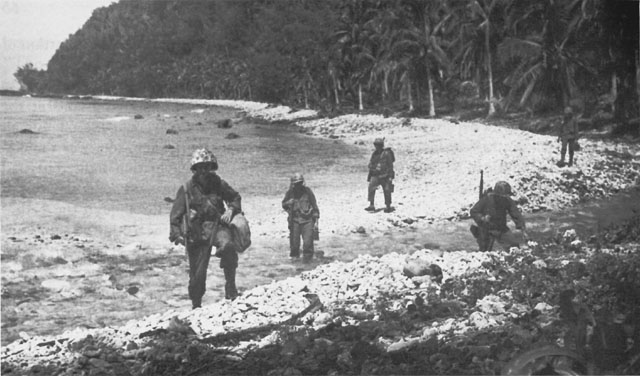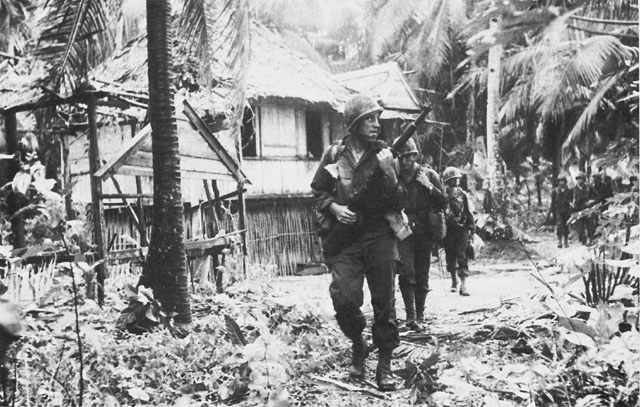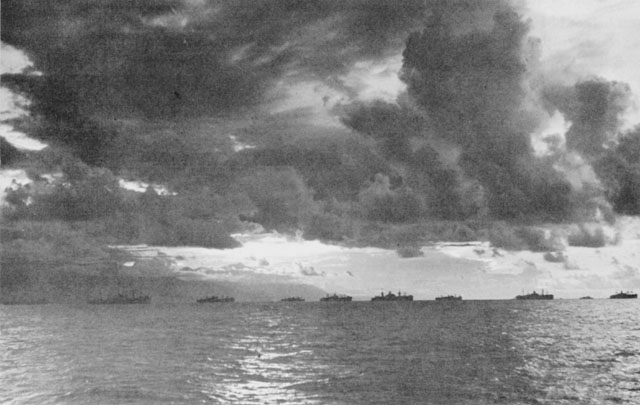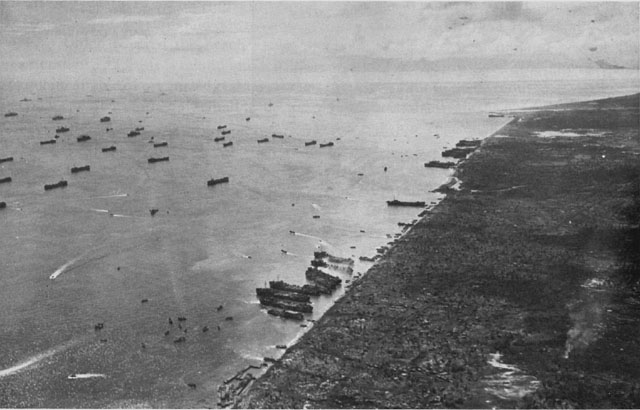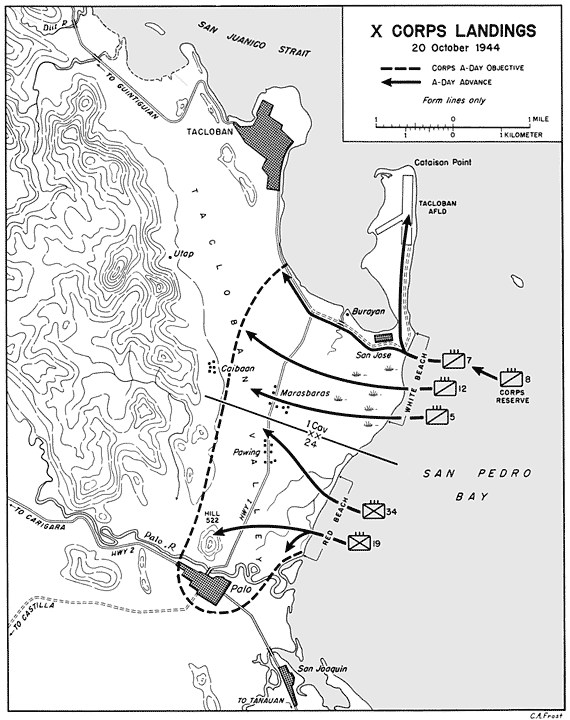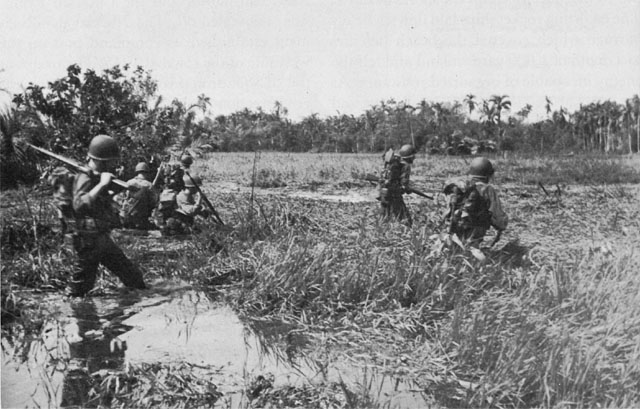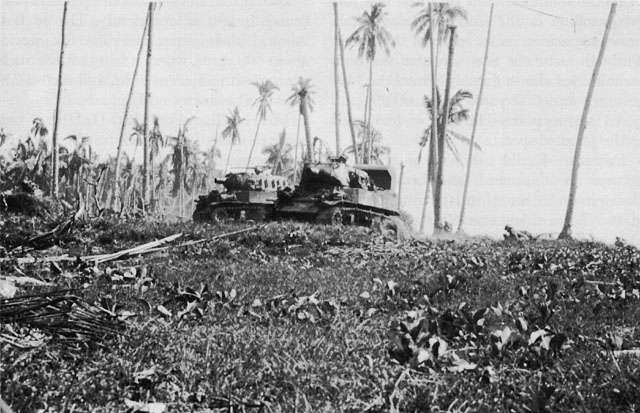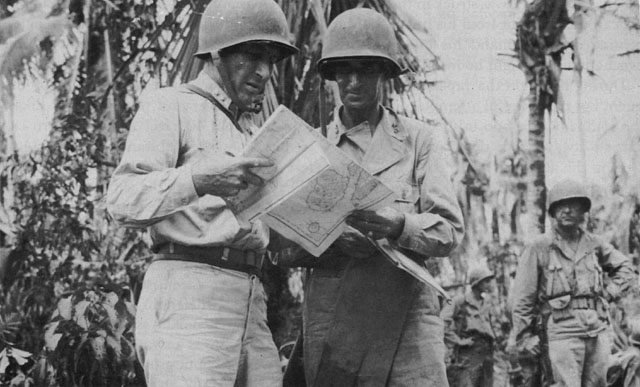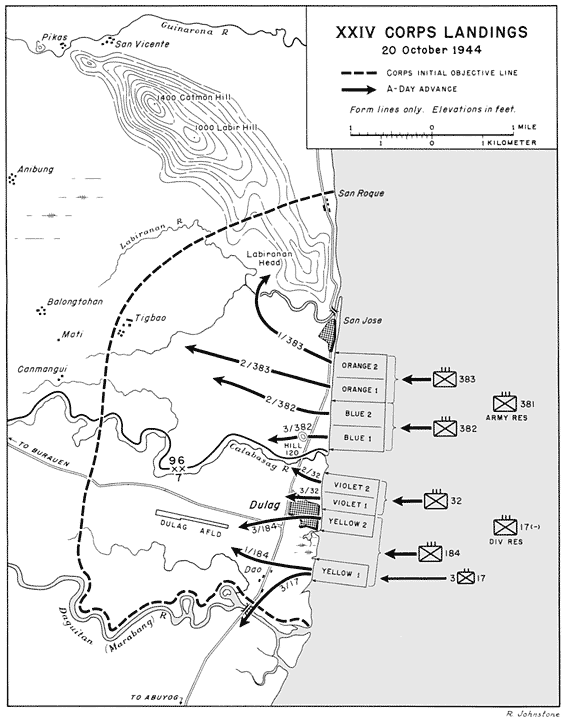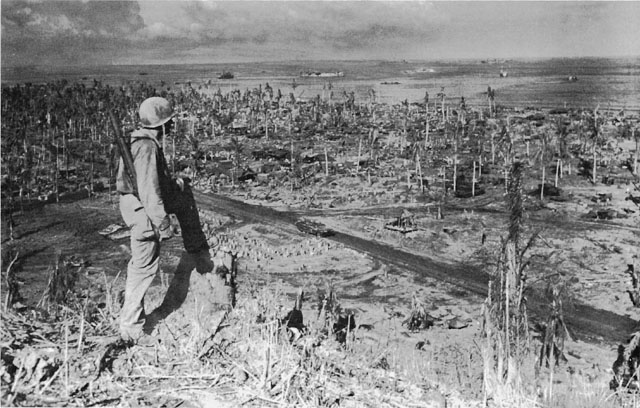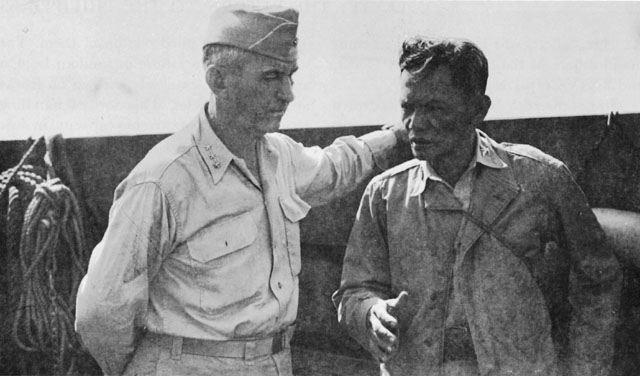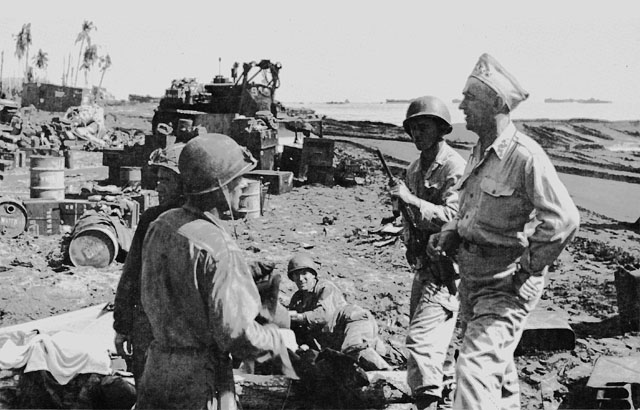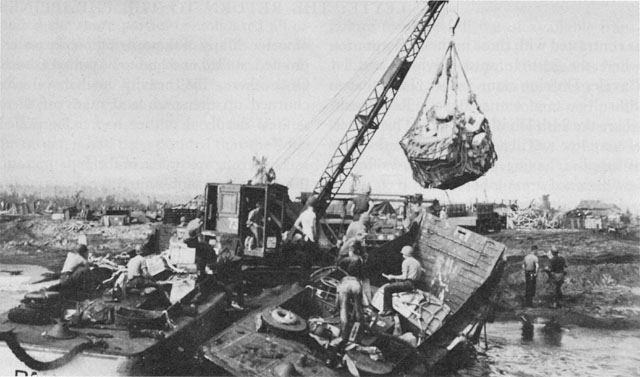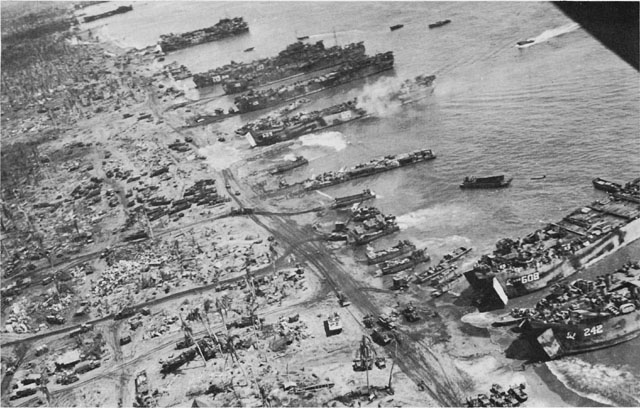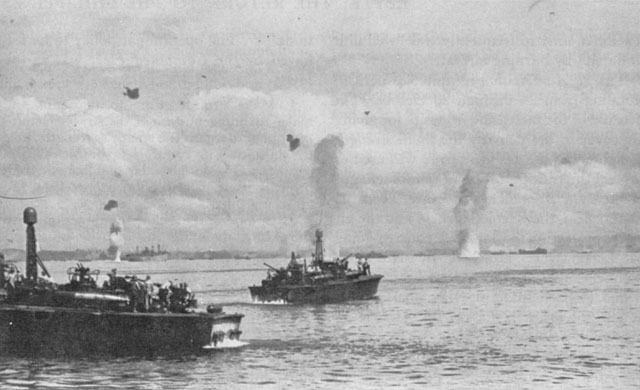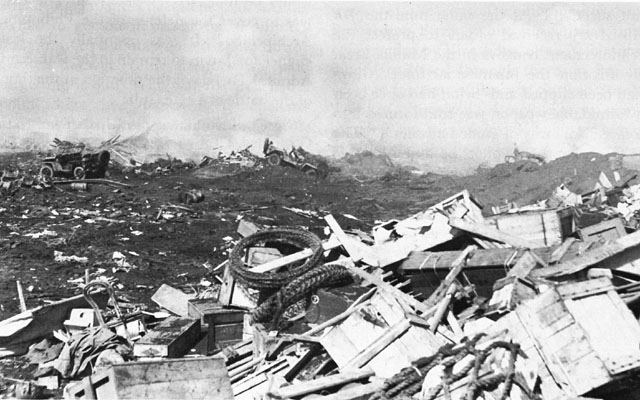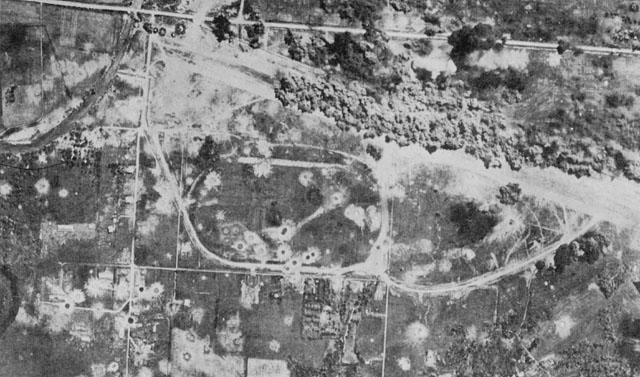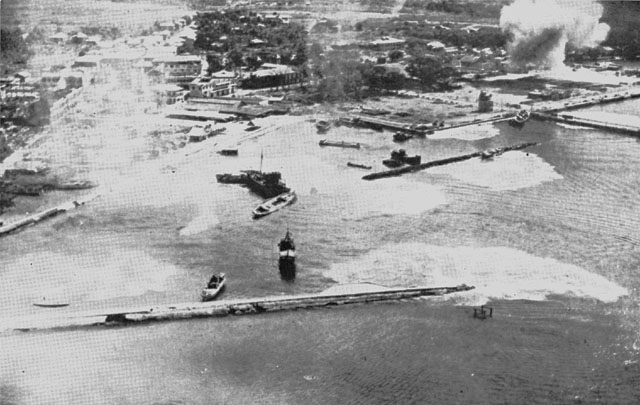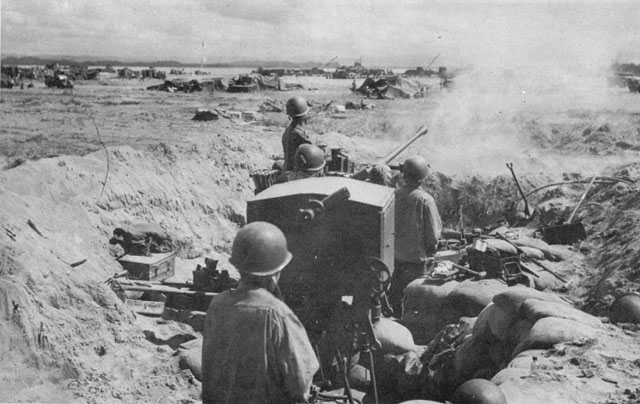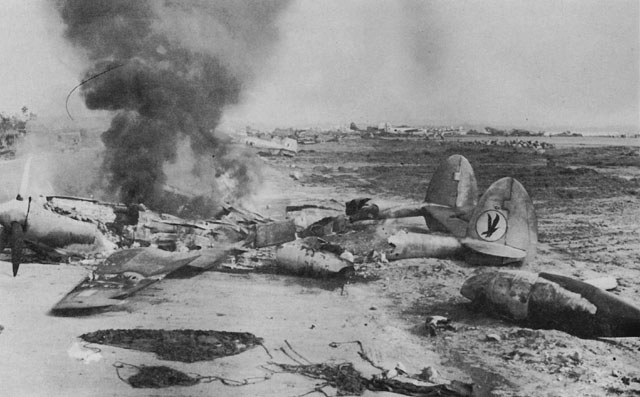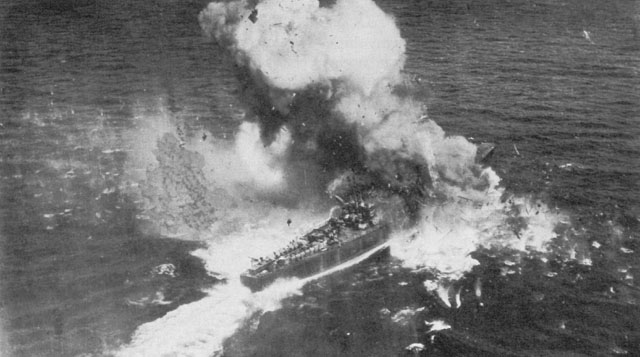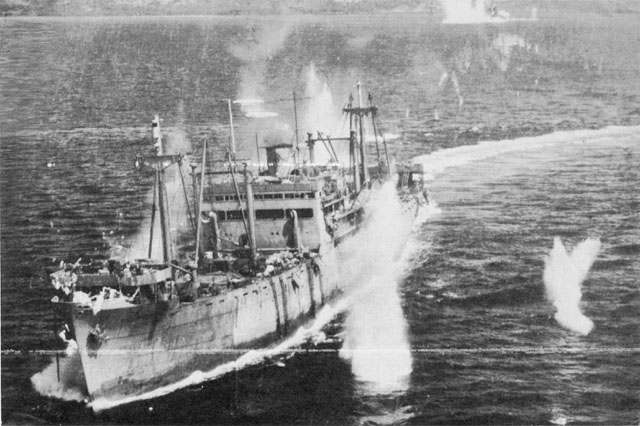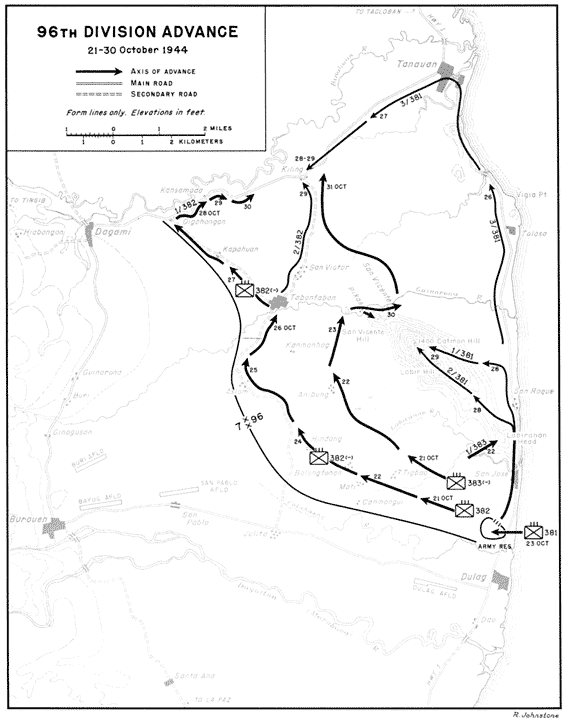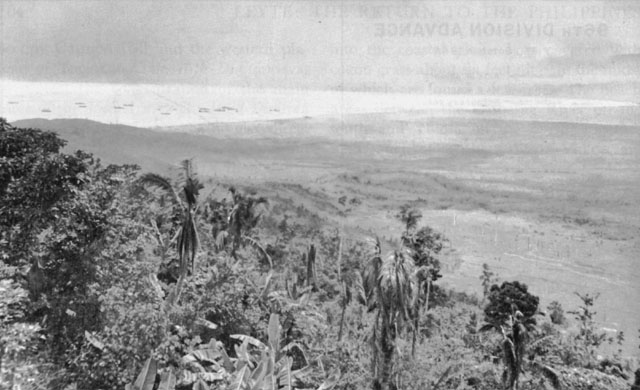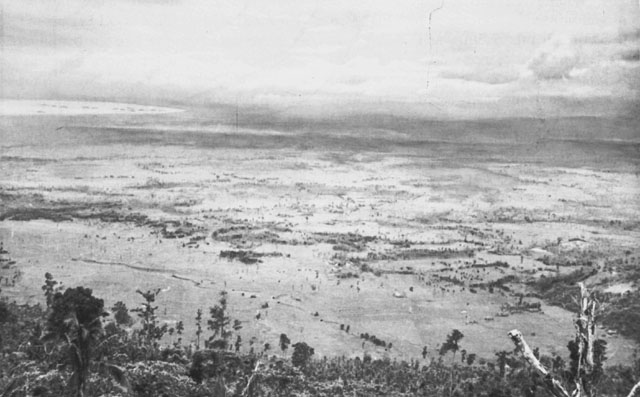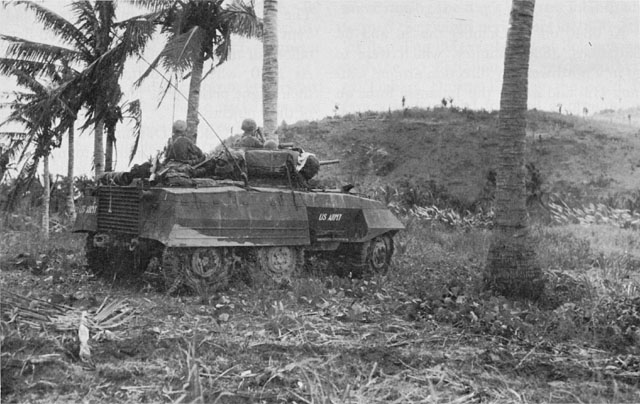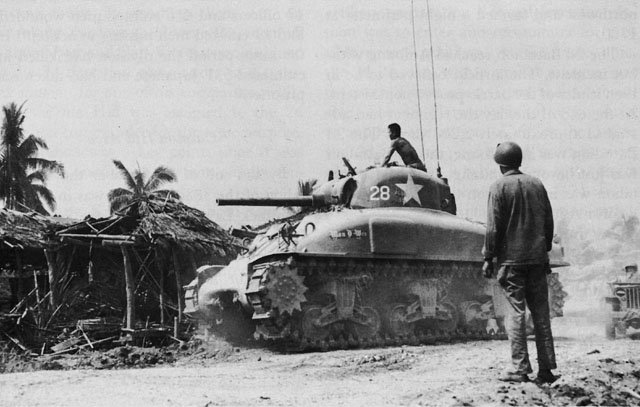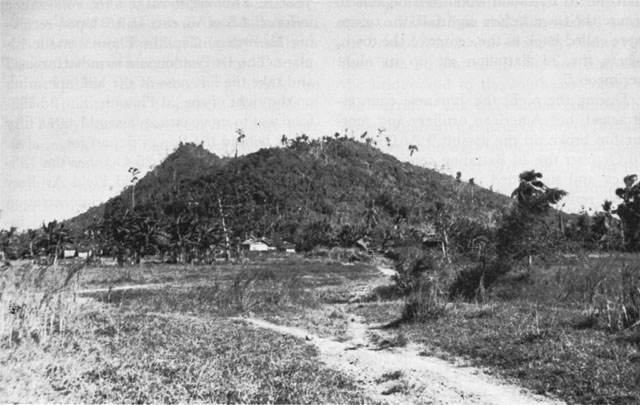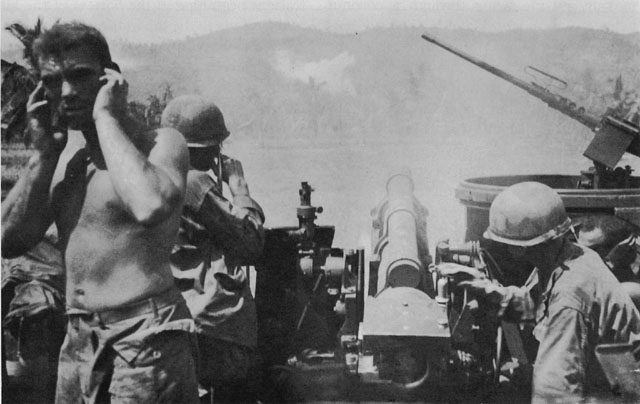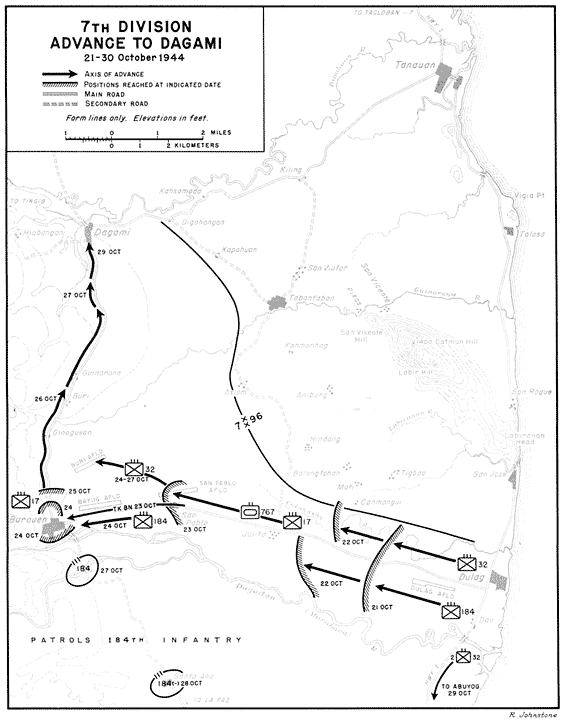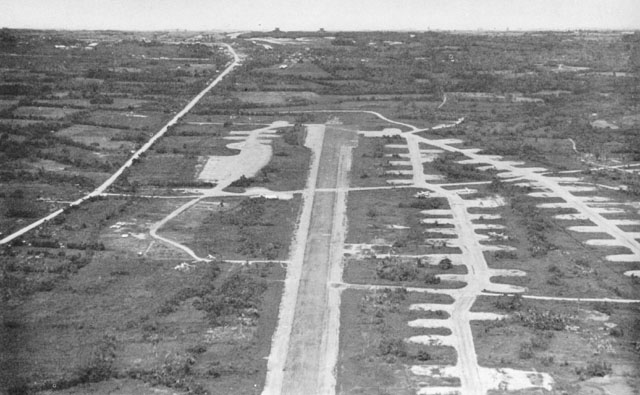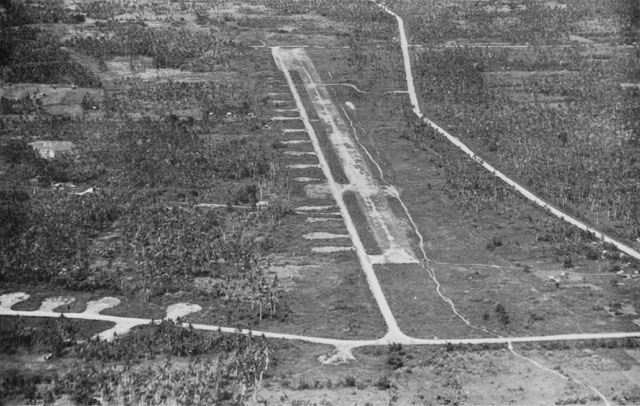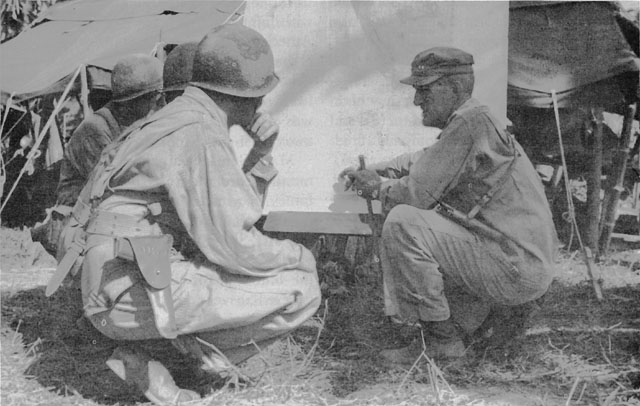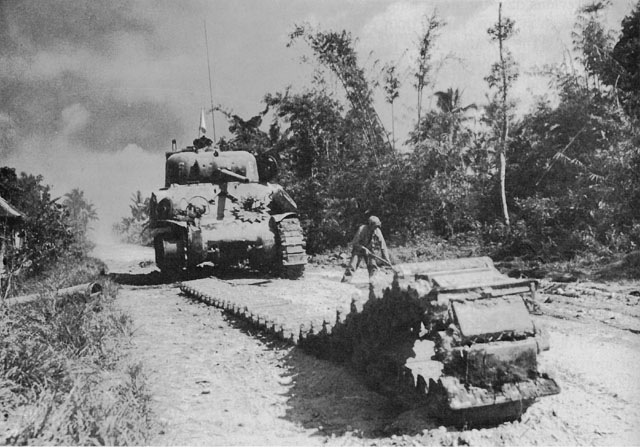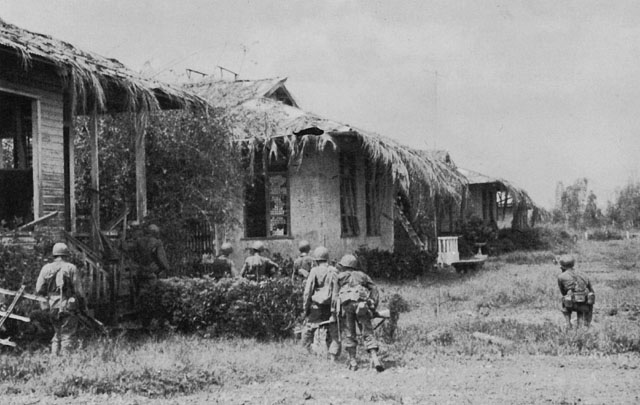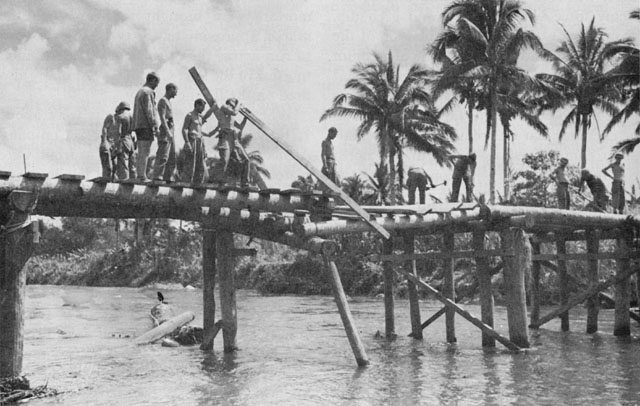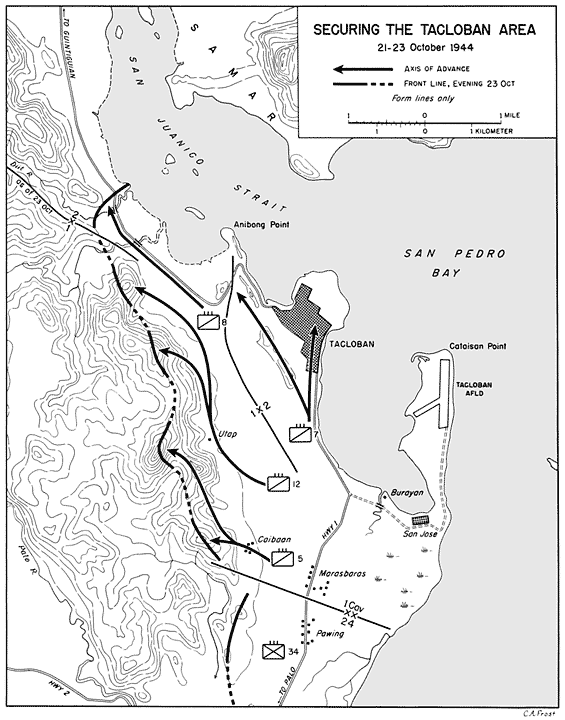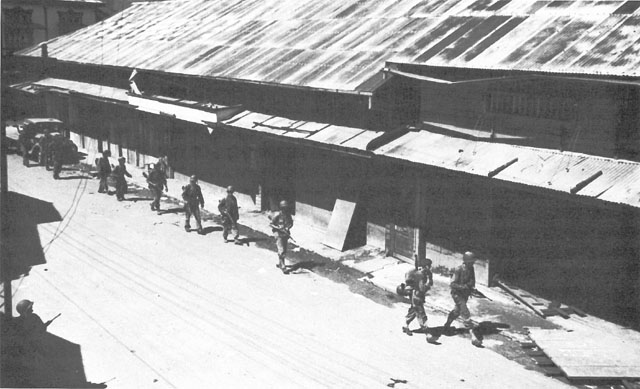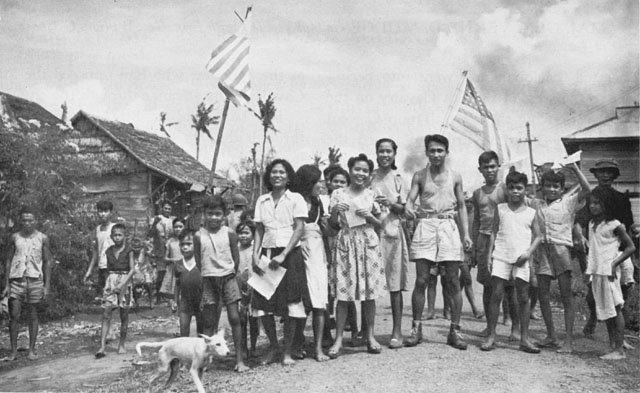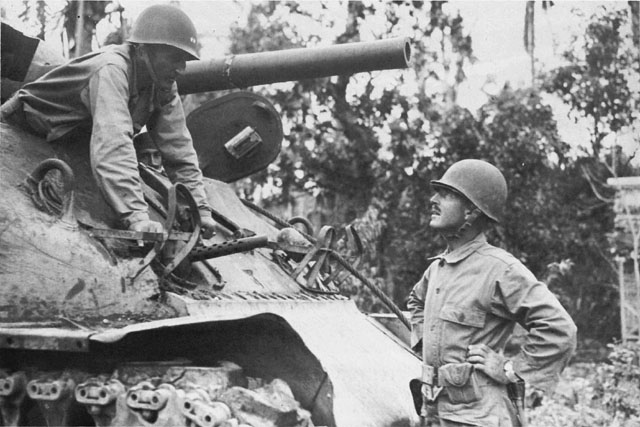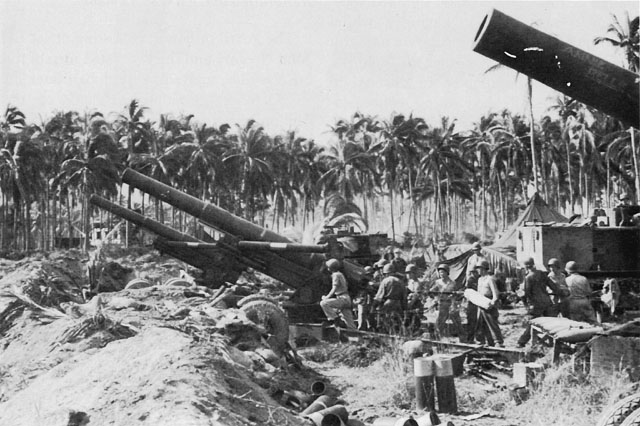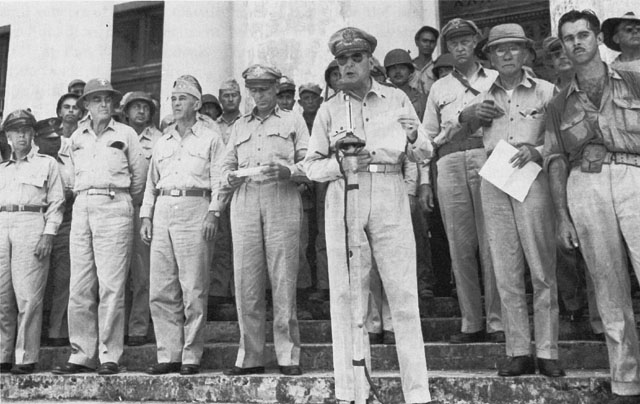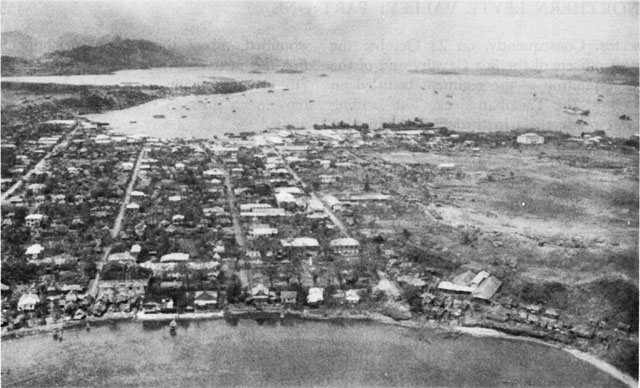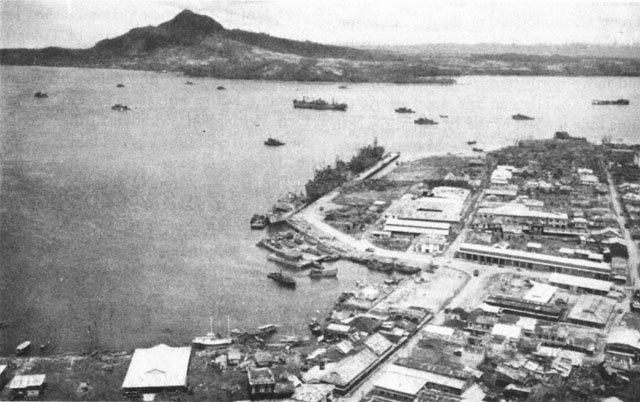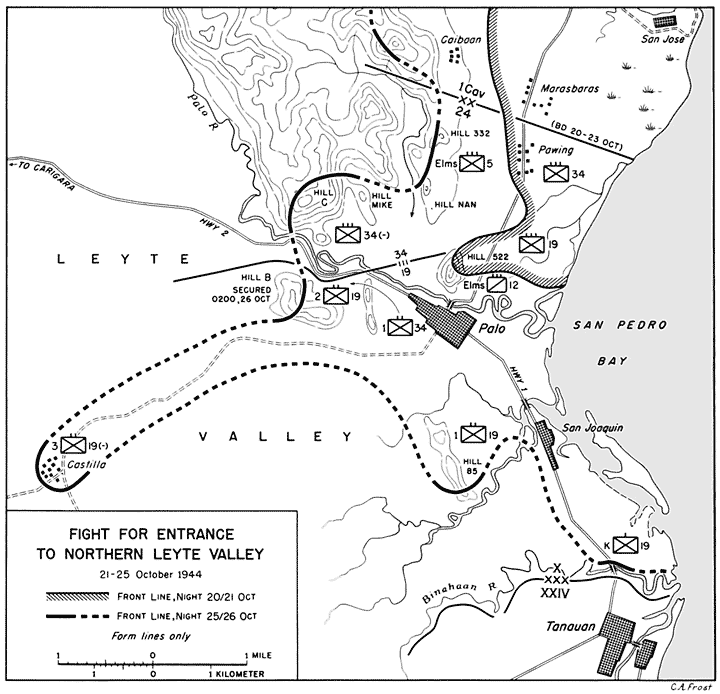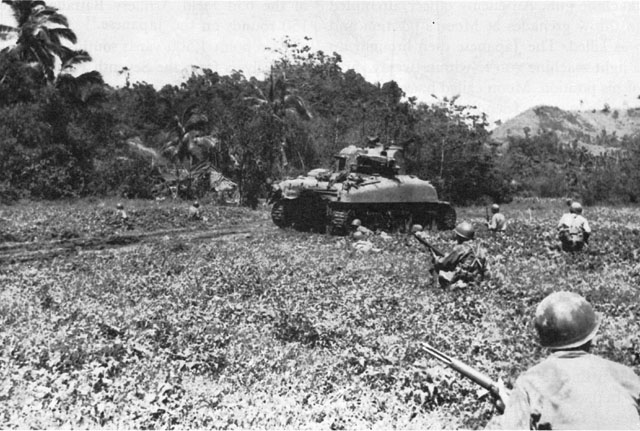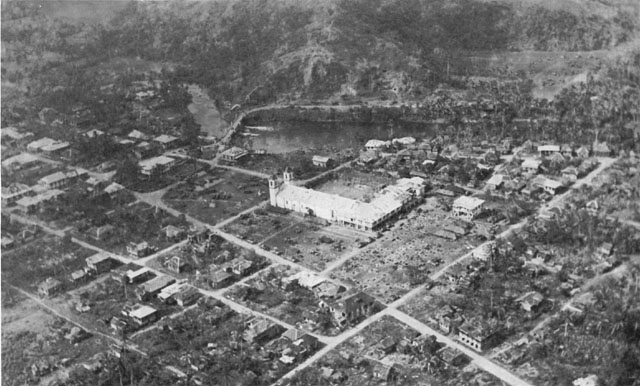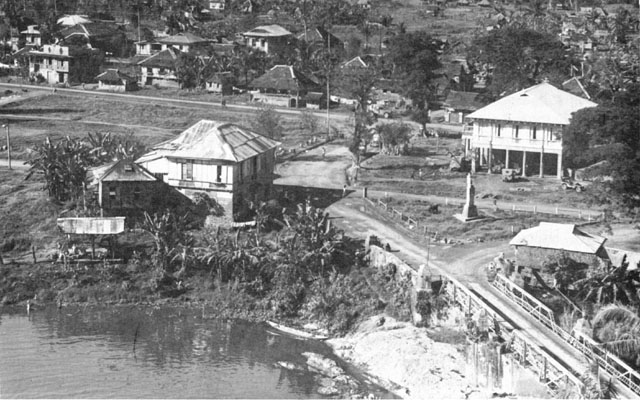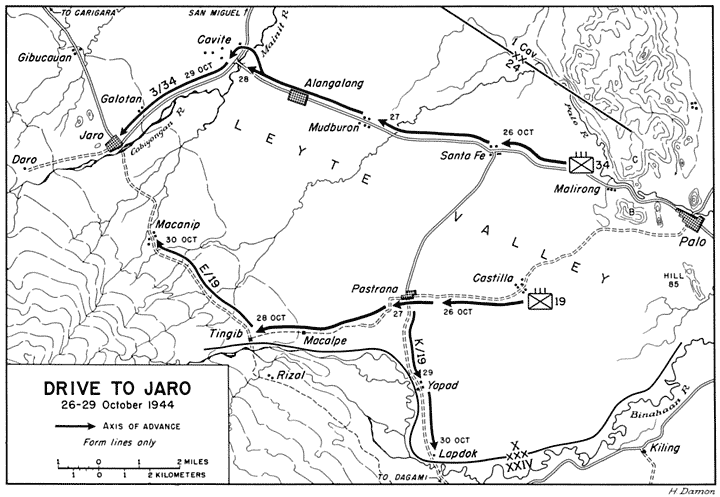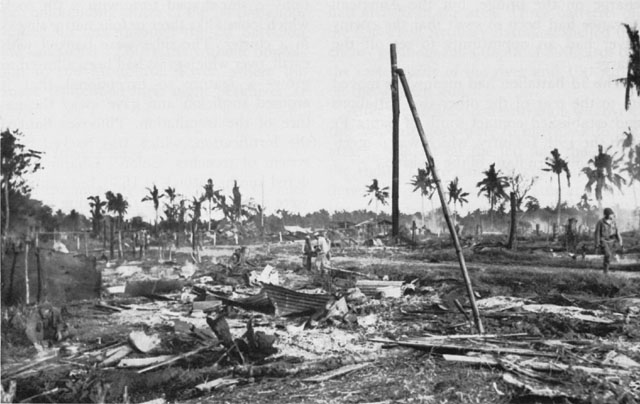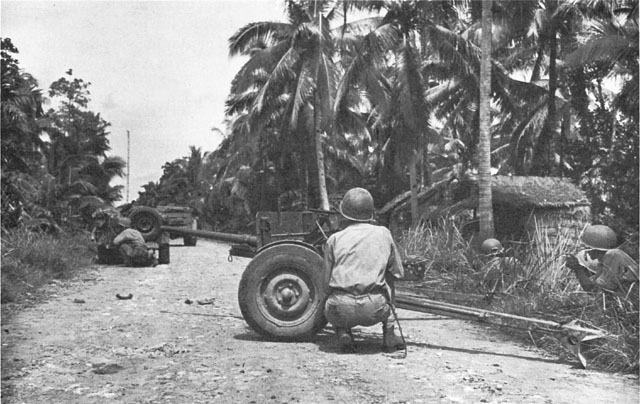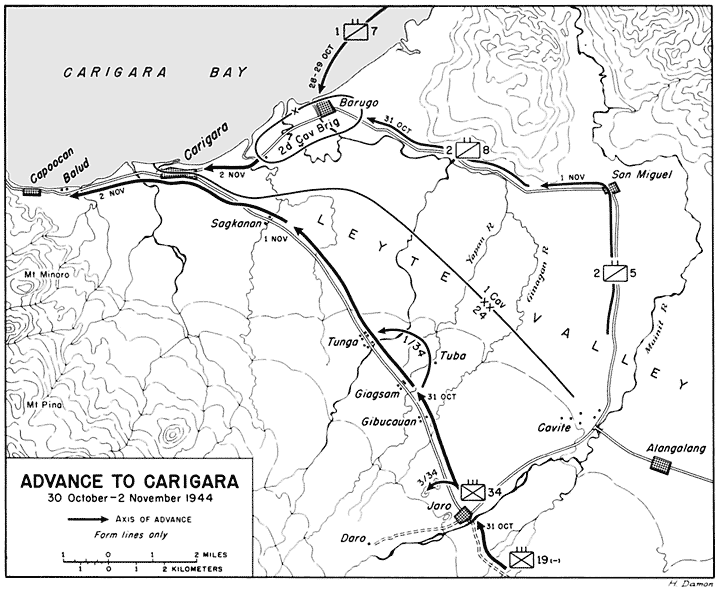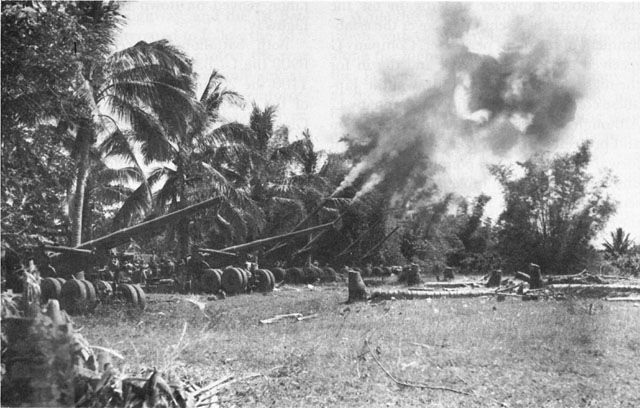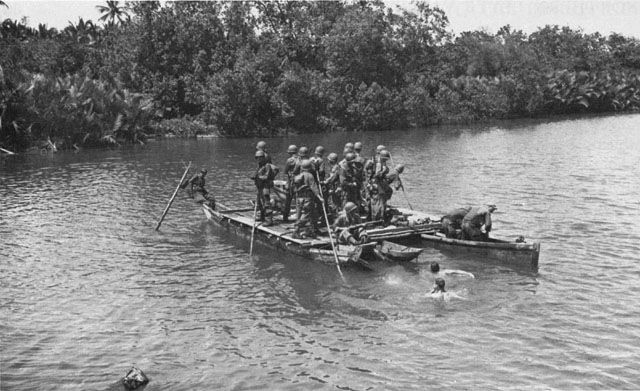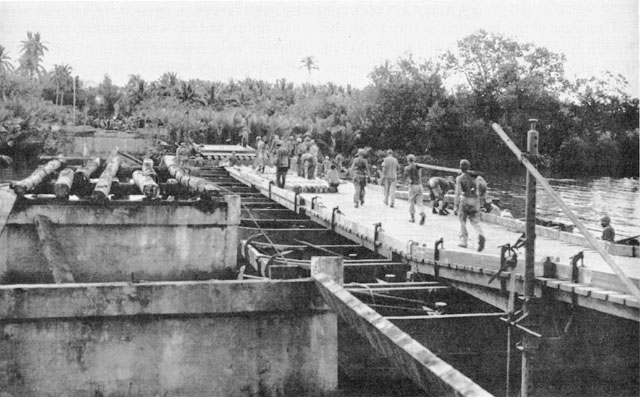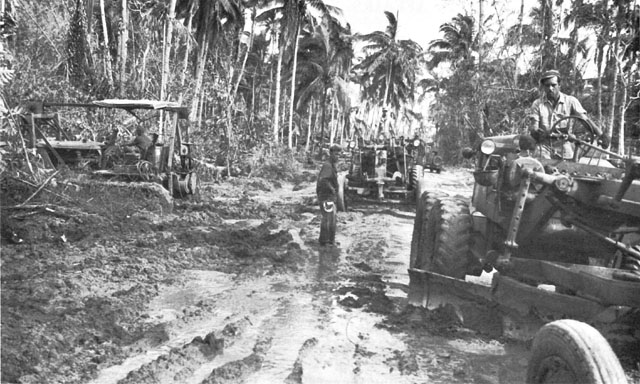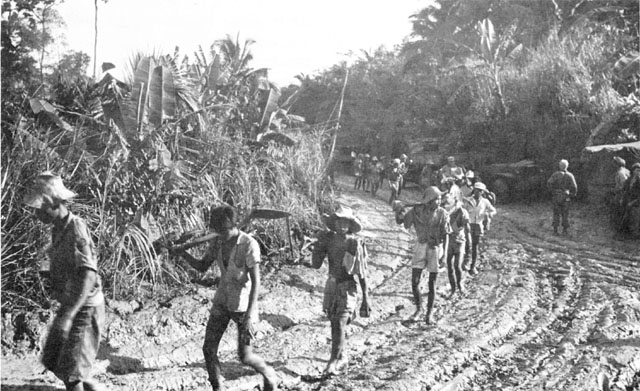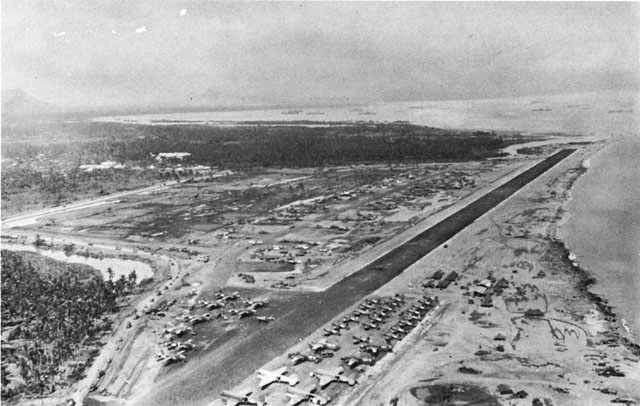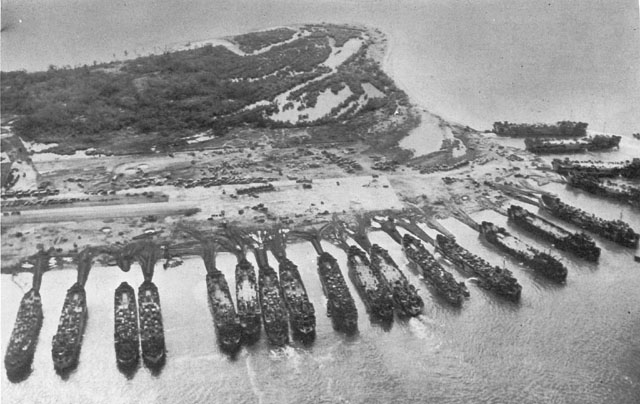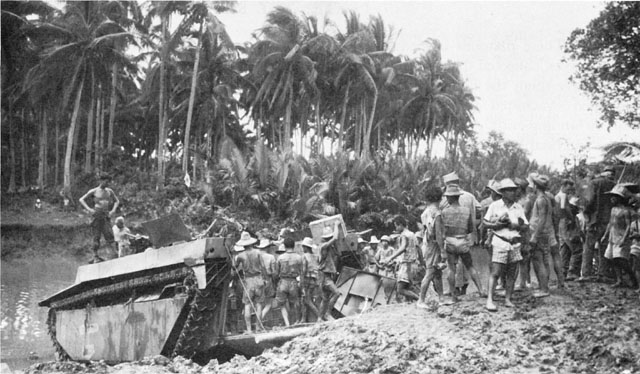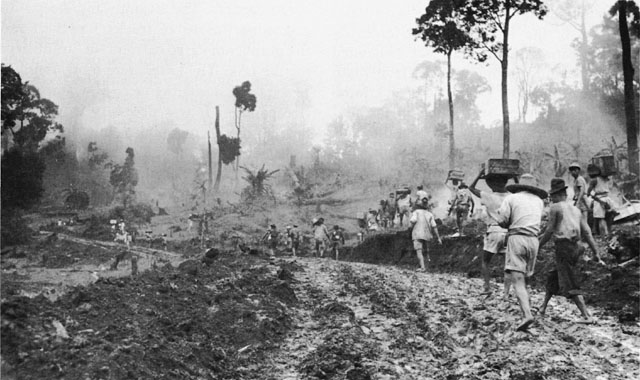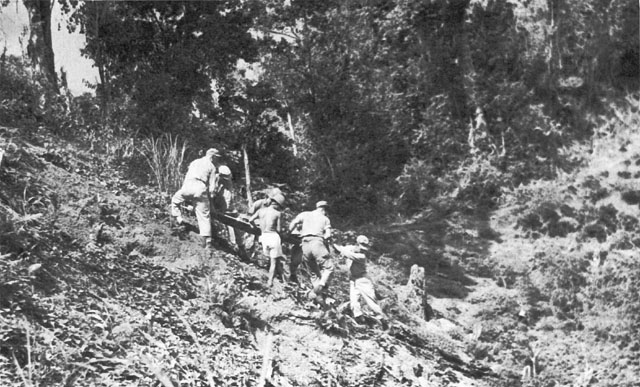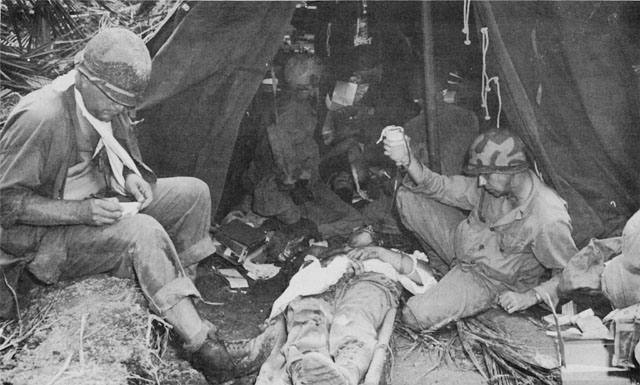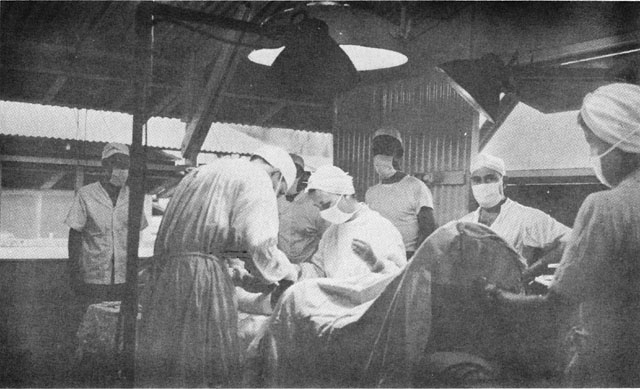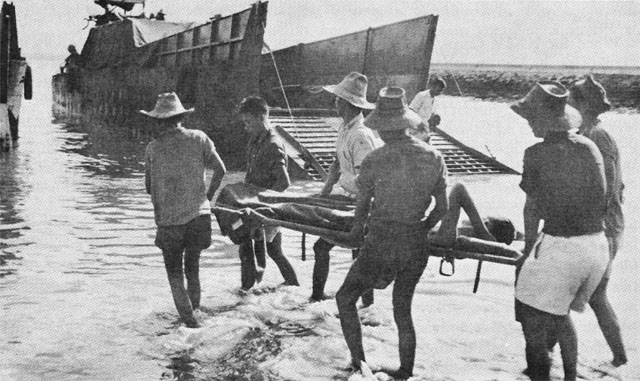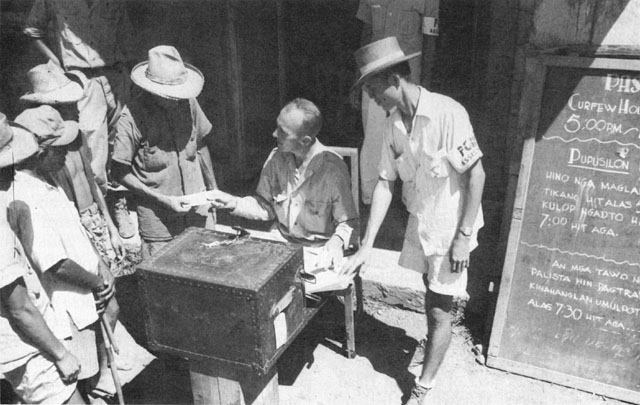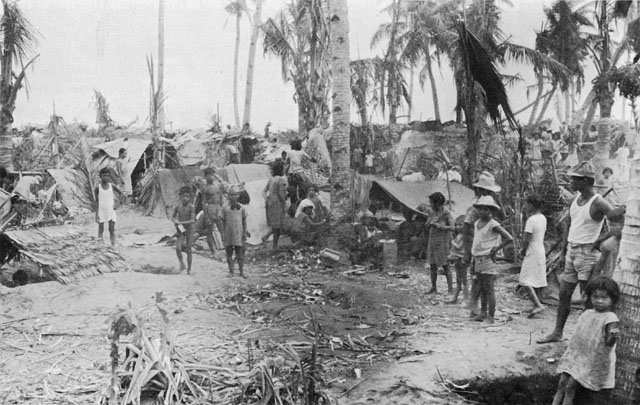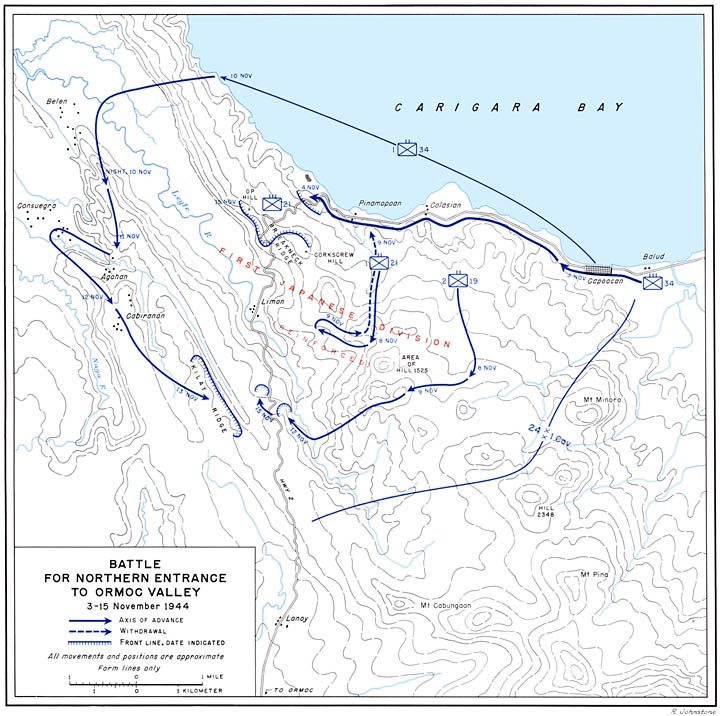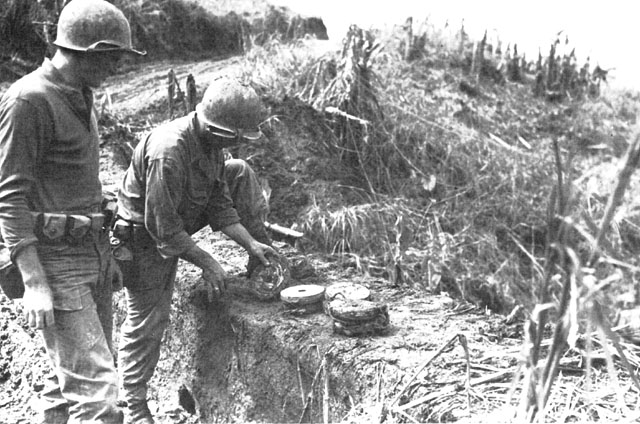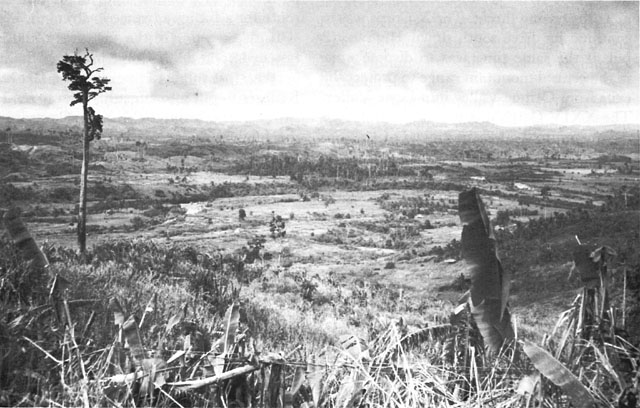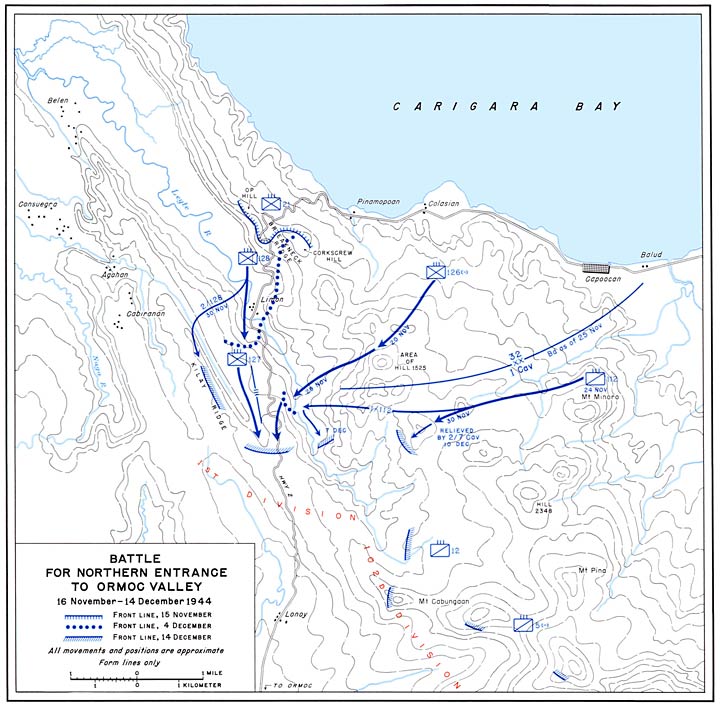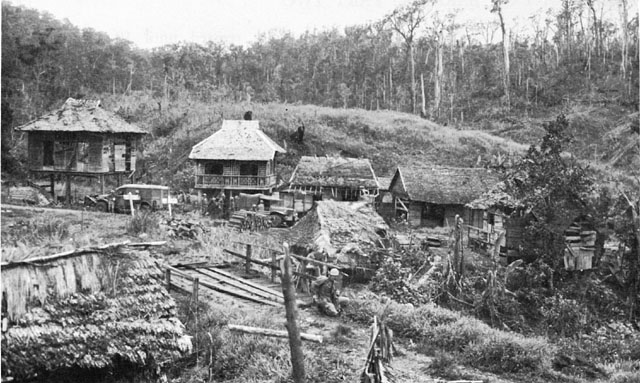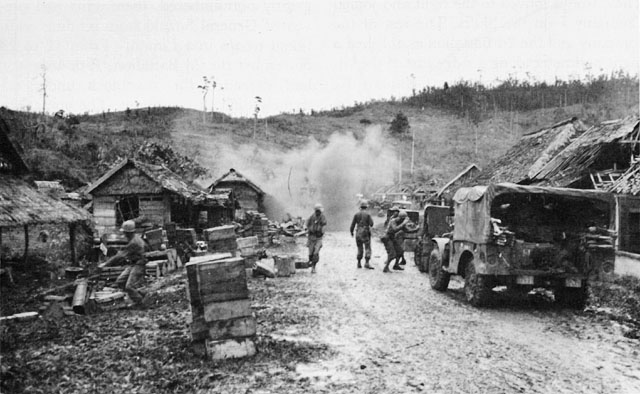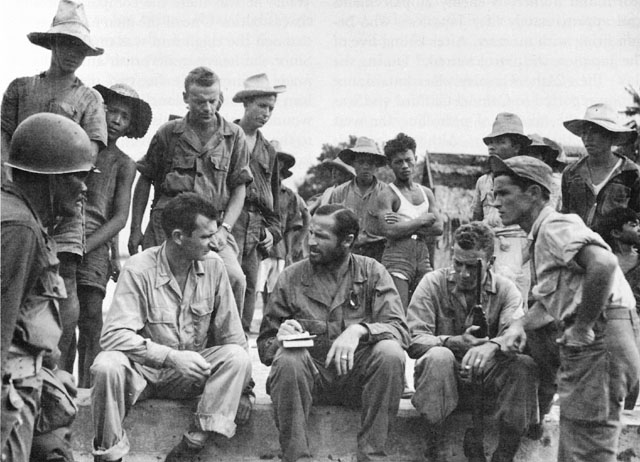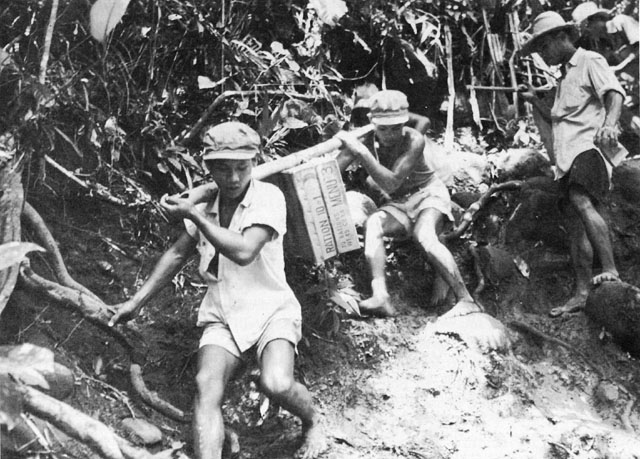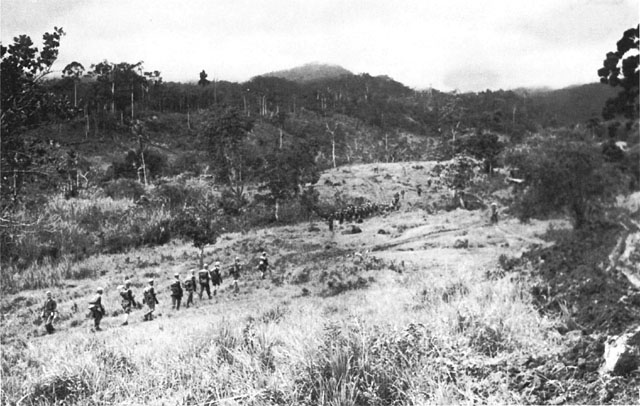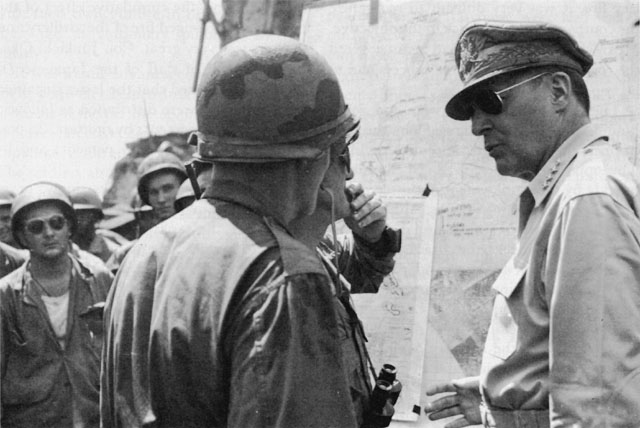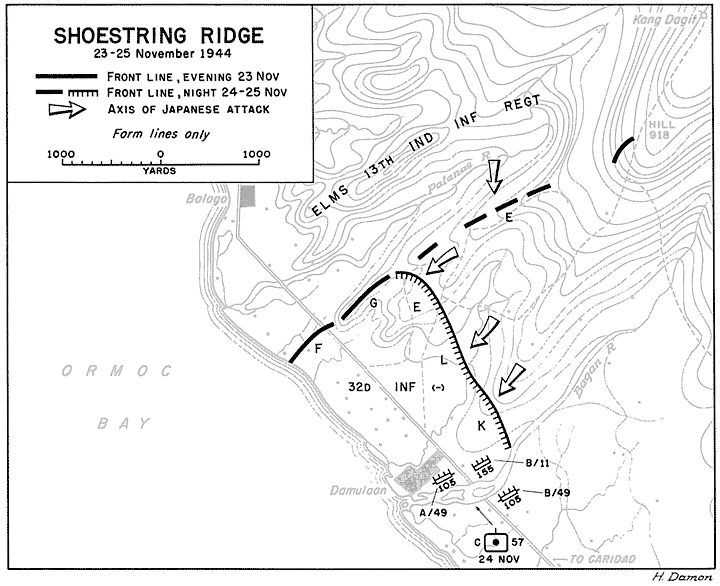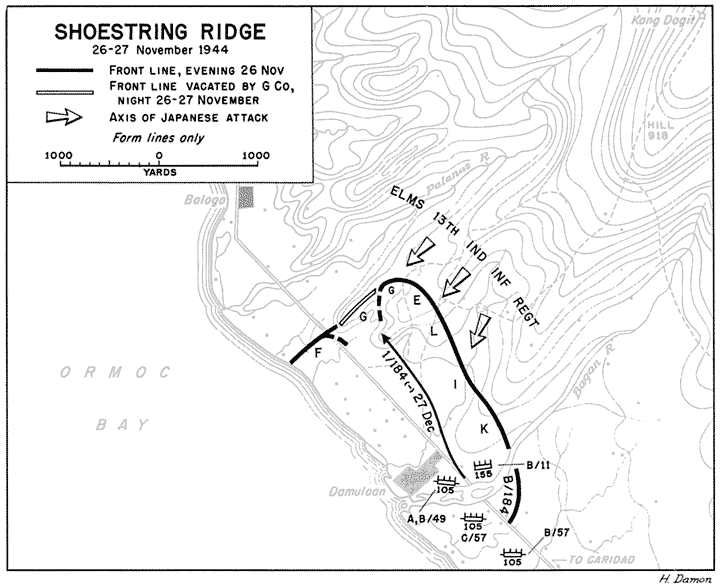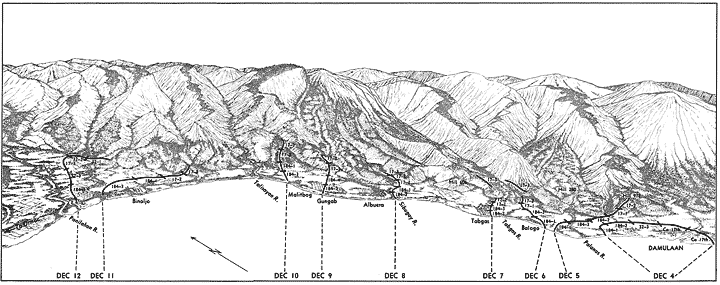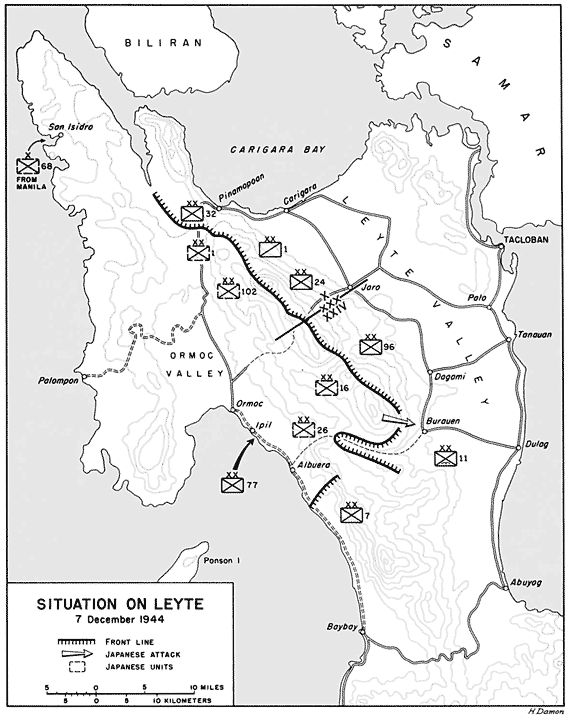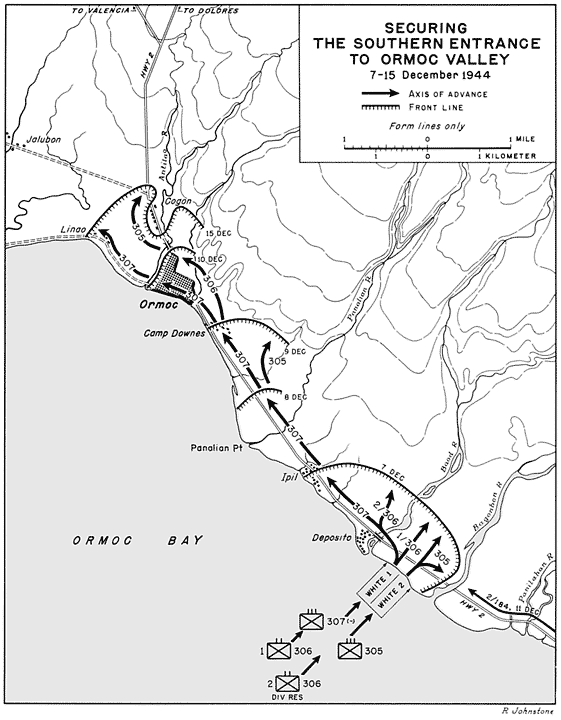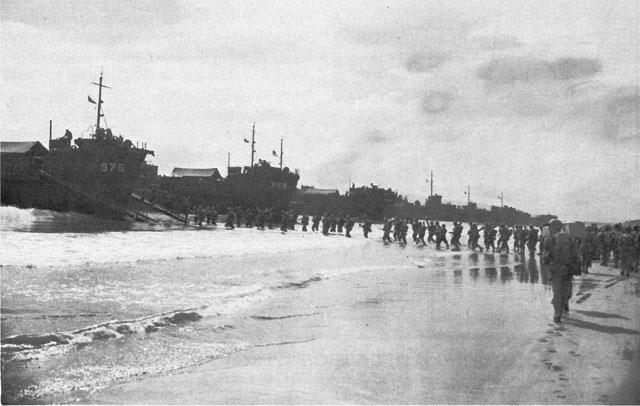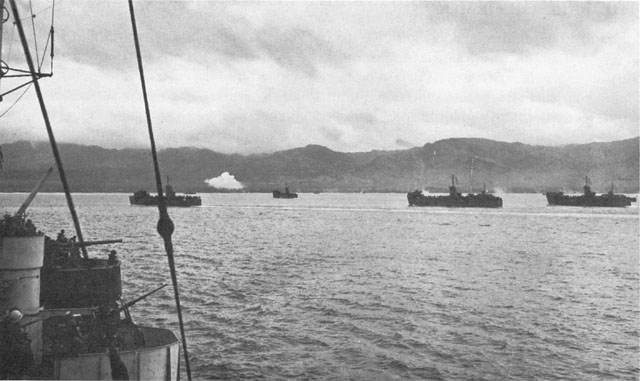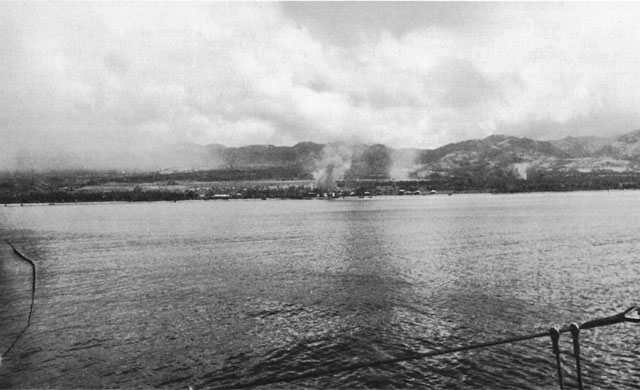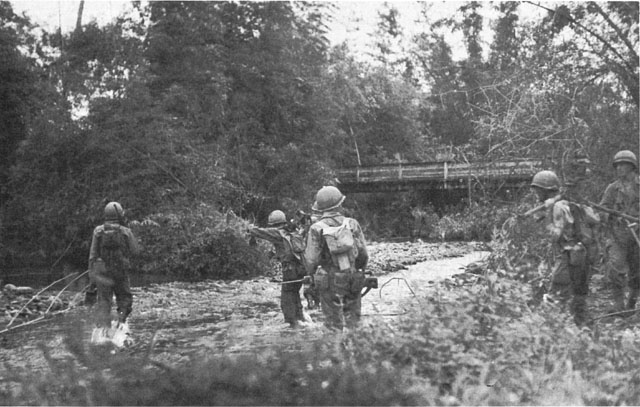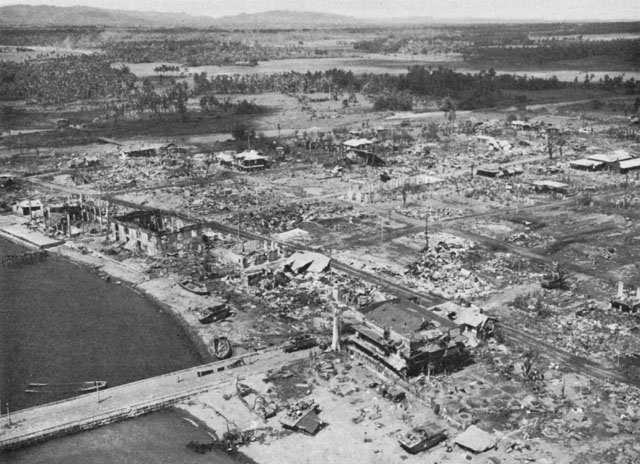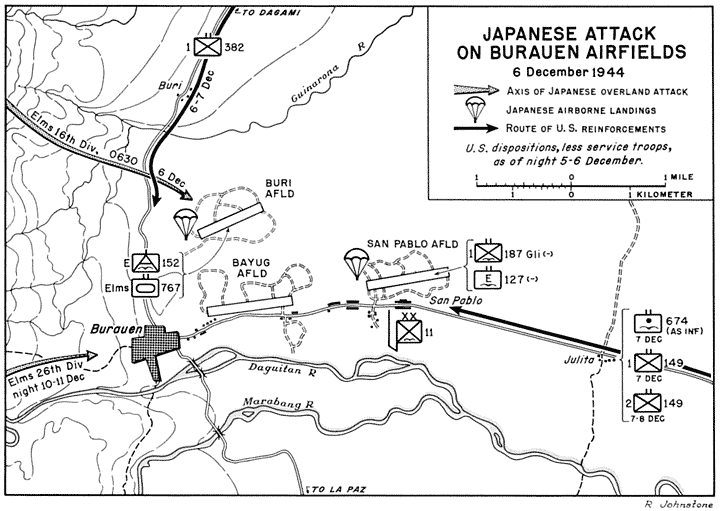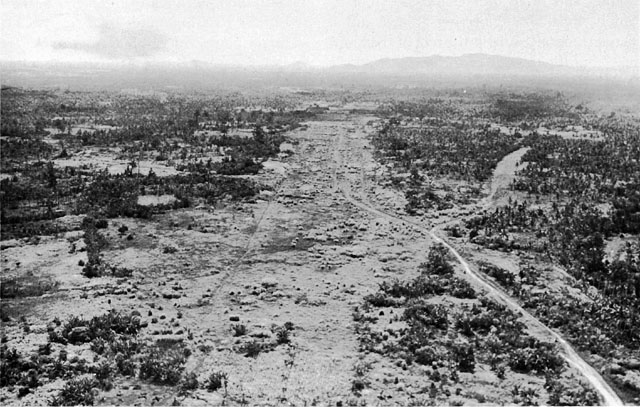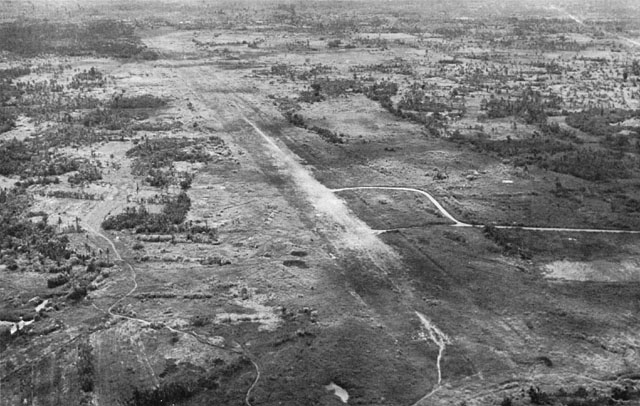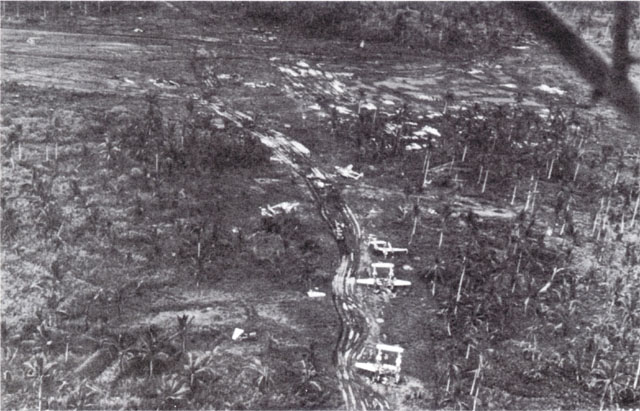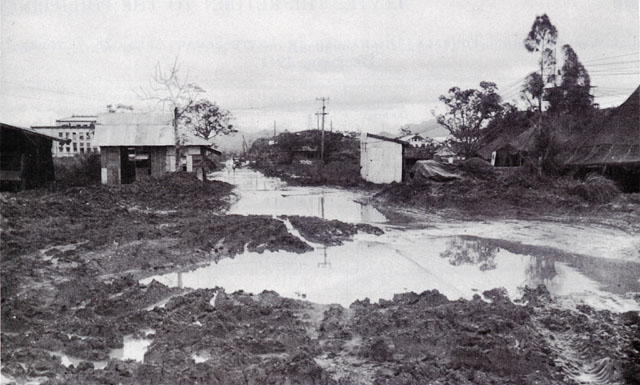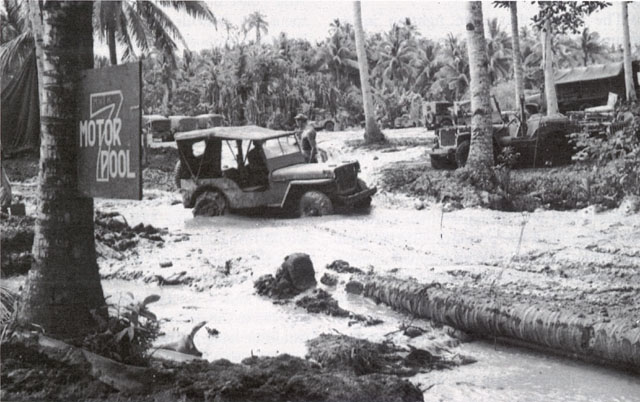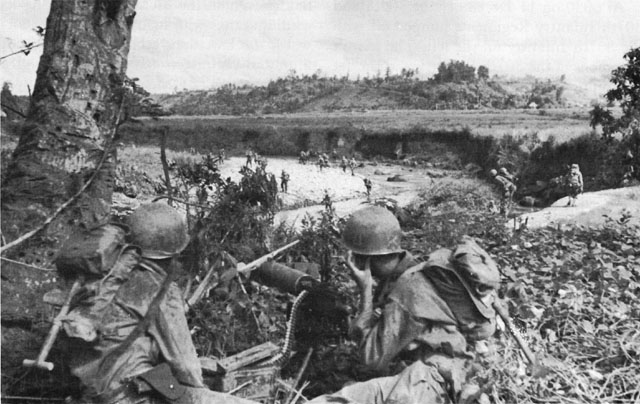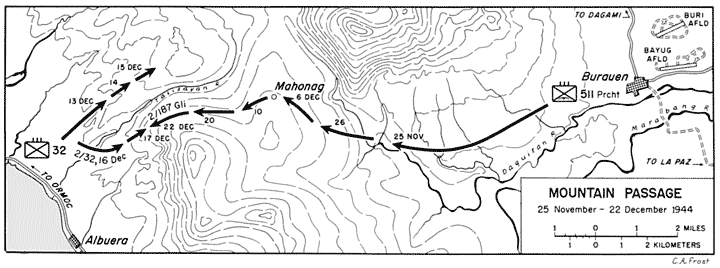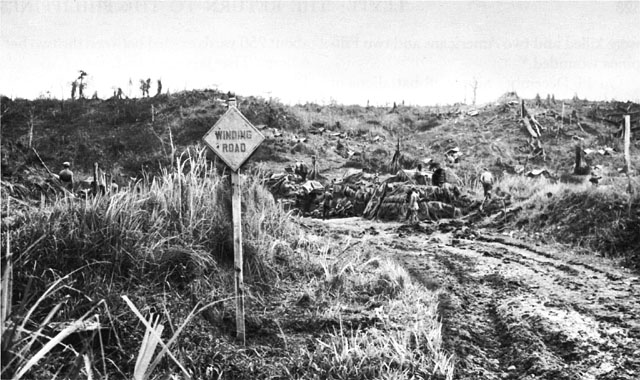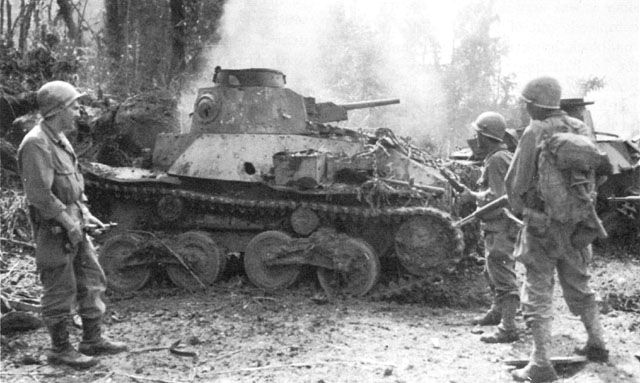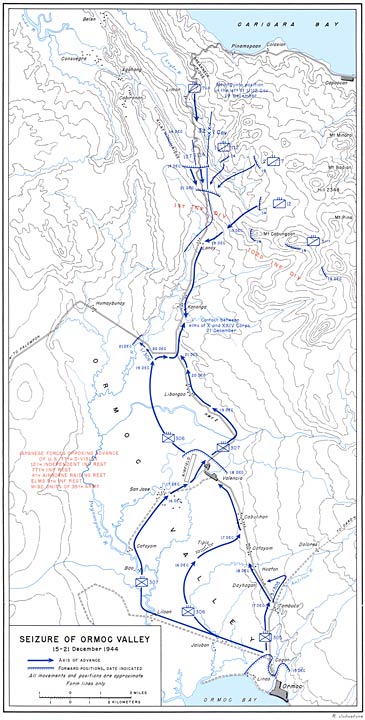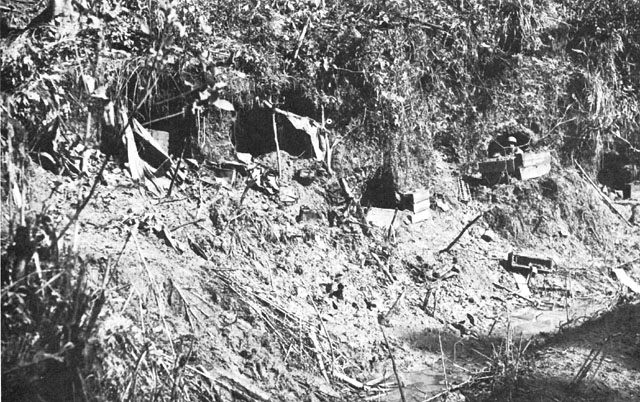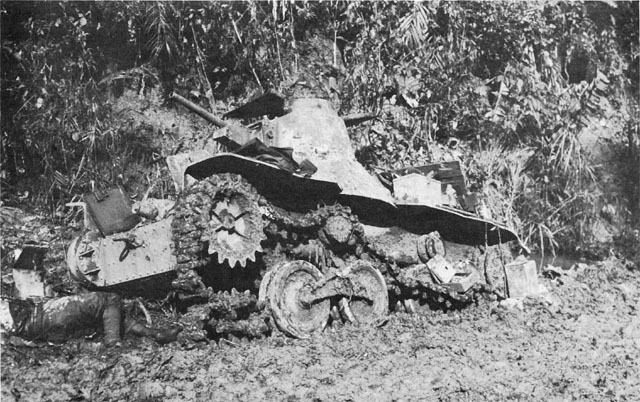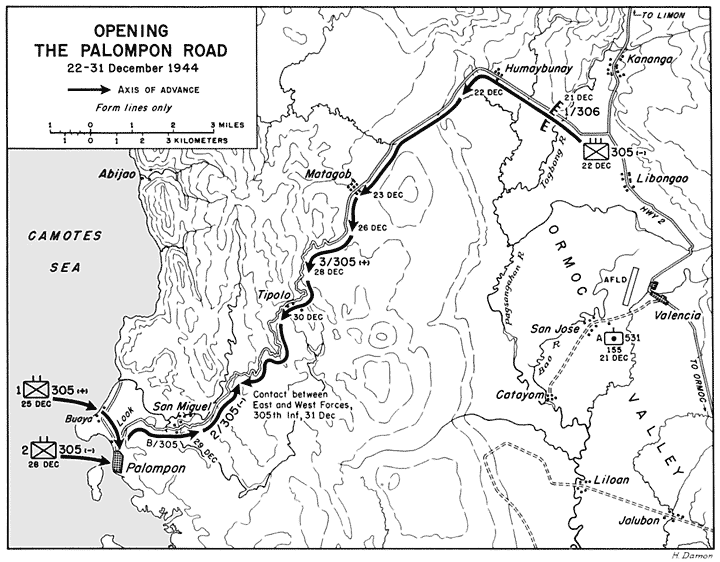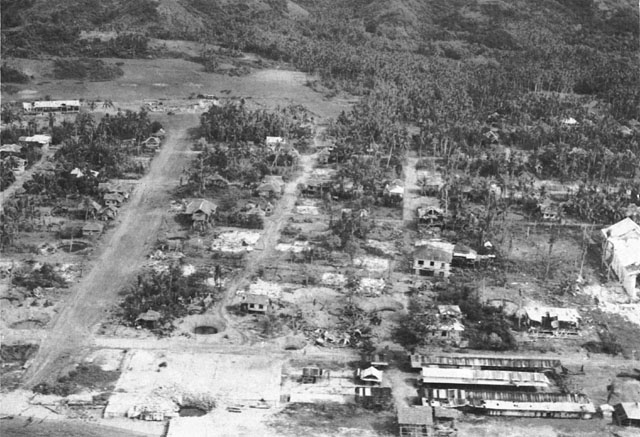A Day
deployment of U. S. forces at end of:
operations: –84
results of naval bombardment on:
Abijao: ,
,
Abuyog: , , ,
, , –45,
, –54, ,
, ,
Admiralty Islands: ,
Aerial photographs:
Aerial reconnaissance. See Reconnaissance,
aerial.
Agahang: –28
Air Assault Force. See Fifth Air Force.
Air attacks, Japanese
on airfields: –88,
on shipping: –88, , ,
on troops: , , ,
on U. S. naval units: ,
Air attacks, U. S.
A Day: –62,
on airfields: , ,
in Arafura Sea:
on artillery positions: ,
on Bacolod airfield:
on bridges: ,
against Burma:
on Camotes Islands: ,
on Cebu: , ,
in Celebes Sea area:
in close support: , ,
on convoys in Ormoc Valley: ,
on Davao area:
on East Indies:
effect of, on Japanese tactics:
estimate of results of, A Day: ,
on Formosa: , , –44
on Japanese aircraft:
on Japanese ground troops: ,
on Japanese naval units: ,
, –91, ,
–102
on Japanese shipping: , , ,
, , –102,
, , –67
on Labiranan Head:
on Leyte: ,
on Luzon: , , ,
against Malaya:
on Mindanao: ,
on mortar positions:
on Negros: , ,
northern Leyte Valley: ,
on Okinawa:
on Ormoc: , –13
in Ormoc area: –84,
on Palaus:
on Palompon: ,
on Panay:
on Philippines: –24,
, –43, –86
plans to launch, against Japan:
on Ryukyus:
on Samar:
in Sulu Sea: ,
on supply dumps:
on Valencia: , , ,
on Visayan Islands:
on Yap:
Air bases: –4.
See also Airfields.
establishment of, planned: ,
–8, –24, ,
–36,
Japanese plans to attack: ,
need of: , ,
shortage of troops to construct:
Air Force, Japanese. See Japanese Air Force.
Air Forces, U. S. See Fifth Air Force; Thirteenth
Air Force; Twentieth Air Force.
Air losses, Japanese: –44, ,
, , , ,
Air losses, U. S.: , , , ,
–99,
Air plans, Japanese: –54,
Air plans, U. S.
to combat Japanese air offensive:
against Japan:
for Leyte Campaign: –3,
, , –28,
missions of Fast Carrier Task Force: ,
missions of Fifth Air Force: ,
mission of Task Force 77:
Air superiority, Allied
attained over Leyte: –44
Kuroda on effect of:
over Philippines: , ,
Air support, U. S.: –8. See also Air plans, U. S.; Fifth Air
Force; Twentieth Air Force.
on A Day: –61
close naval, of ground troops:
estimate of:
factors affecting: –94
lack of, in attack on Formosa: –4
lack of, in 6th Ranger operations:
MacArthur on availability of, 1944:
for Ormoc operation: , –80
Air units, Allied. See also Allied Air Forces;
Fifth Air Force; Thirteenth Air Force; XIII Bomber Command; Twentieth
Air Force.
5th Bombardment Squadron:
V Fighter Command:
7th Fighter Squadron: –98
9th Fighter Squadron:
11th Air Cargo Resupply Squadron: [392]
42d Bombardment Group:
49th Bomber Group: –99
49th Fighter Group:
307th Bombardment Group:
308th Bombardment Wing: ,
, –13, ,
341st Fighter Squadron:
347th Fighter Squadron:
868th Bombardment Squadron:
Airborne Battalions
2d, 187th Glider:
2d, 511th Parachute Regiment:
3d, 511th Parachute Regiment:
127th Engineer,
Airborne Division, 11th: ,
commander of:
and defense of airfields: –98, ,
, –05
in Mahonag area:
missions of: –23,
mopping-up operations of:
Airborne operations, Japanese: –96, –305
Airborne Regiments
187th Glider: , , –04,
511th Parachute: , –23
Aircraft, Japanese: , , , ,
Aircraft carriers, Japanese: –91
Aircraft carriers, U. S.: , , , –41, ,
, –61, ,
–92
Airdromes. See Airfields.
Airdrops: ,
, –32, ,
,
Airfields: 99. See also Air bases; towns as main
entries.
Bacolod: ,
Bayug: , , , , , , , , ,
Burauen: , , ,
, , , –97, –305, ,
–14, –22
Buri: , , , –38, , , –300, –05
Clark Field:
condition of: ,
constructed by Japanese on Leyte:
construction of: –36,
–88, , –08
Davao: ,
Dulag: , , , , ,
, , –29,
, , , , –95, ,
, ,
estimate of Japanese: –23
Japanese attempt to retake: –305
Kuroda on construction of Japanese: –50
on Leyte: , , , , ,
, , –62,
, 107.
See also airfields by name.
on Mindanao:
San Pablo: , , –34, ,
, , , –303
Tacloban: , , ,
, , , , ,
, , –88,
–98, , ,
, , , 190
, , ,
Tanauan: ,
Valencia: , , ,
, , ,
in Visayan Islands:
Airstrips. See Airfields.
Aitape:
AKA’s: ,
Alamo
Force: , 26. See also
Sixth Army, U. S.
Alangalang:
Albuera: ,
, , , , , ,
Allied Air Forces: 306. See also Air units,
Allied; Fifth Air Force; Thirteenth Air Force; Royal Australian Air
Force.
command of: , ,
composition of:
missions of: , , ,
–96, ,
Allied Land Forces: , 26. See also Sixth Army, U. S.; X Corps; XXIV
Corps.
Allied Naval Forces. See also Seventh Fleet;
Central Philippine Attack Force; Task Force 77; Task Force 78; Task
Force 79.
command of: , –26
composition of: –26,
–30
missions of: , –26, –30, ,
Ambush. See Tactics, Japanese.
Ammunition: ,
,
shortage of: ,
supply of: , –38,
supply operations for: ,
Ammunition and Pioneer Platoon, 19th Infantry:
Amphibian tanks. See Tanks, U. S., amphibian.
Amphibian tractors: , ,
Amphibian truck battalions:
Amphibious forces: –42. See also III Amphibious Force; VII
Amphibious Force.
Amphibious operations:
casualties during: , , ,
command of:
on east coast of Leyte: –80
Leyte to Samar: –57
logistical operations in, A Day: –84
mine sweeping:
in northwest Leyte:
at Ormoc: –23
in Ormoc area: –84,
in Palompon area: –51,
plans for: , –39,
of 6th Rangers: –55
underwater demolition teams: –58
on west coast of Leyte: –67
Anchorages. See Harbor facilities; Ports.
Anguar:
Anibong Point: ,
Anibung: ,
–11, ,
[393]
Antiaircraft fire, Japanese: , , ,
Antiaircraft fire, U. S.:
Antilao River: ,
–16,
Antipolo Point:
Antitank Companies:
of the 17th Infantry:
of the 307th Infantry:
APA’s:
APH’s:
Area Allocation Group:
Arisue, Maj. Gen. Seizo:
Armies, Japanese. See Japanese Army units,
Armies.
Armies, U. S. See Eighth Army, U. S.; Sixth Army,
U. S.
Army Service Command. See Sixth Army Service
Command.
Arnold, Maj. Gen. Archibald V.
and advance on Burauen: –33
command of:
in Ormoc Valley:
tactical plans of: , –56, , , ,
Arnold, General Henry H.: , ,
Artillery, Field. See Field Artillery
Battalions.
Artillery, Japanese
air attack on: ,
estimate of:
use of: , , ,
Artillery, U. S.: , , –64
Catmon Hill: –20
close support: , –37, , , , , , , , , –40, –19
concentrated preparations:
failure to land, A Day:
Krueger on:
on Labiranan Head: –08
San Vicente Hill:
at Shoestring Ridge: , –58, ,
at Tabontabon: –17
Arafura Sea:
ASCOM: See Casey, Maj. Gen. Hugh J.; Logistics;
Sixth Army Service Command.
Aslom:
Assault craft: –8. See also by name.
Atago:
Attu:
Austin, Capt. Paul: –61
Australia: ,
Australian Air Force. See Royal Australian Air
Force.
Avengers: –62
Awards. See by name.
B-24’s: ,
Babatngon: –55, –75
Bacolod: ,
,
Bagacay:
Bagonbon River: , ,
Bailey bridges: ,
Balanac:
Balud:
Balaud:
Balogo: –67, –71
Bao: –31
Bao River:
Baod River: , , , , ,
Barbed wire:
Barbey, Rear Adm. Daniel E.: –26, 28. See also Northern Attack Force;
Task Force 78.
BAR’s. See Weapons, U.S. Browning automatic
rifles.
Barugo: , , ,
, , , –81, , , ,
Basey: ,
,
Bataan:
Battalions, Japanese. See Japanese Army units,
Battalions.
Battalions, U.S. See Airborne Battalions;
Engineer Battalions; Field Artillery Battalions; Infantry Battalions;
Tank Battalions; Tractor Battalions.
Battle of the Hills: –73
Battle of Leyte Gulf: , , , ,
effect of, on Japanese tactics:
effect of, on U. S. tactics:
Japanese estimate of:
Japanese tactics for:
operations: –92
results of:
Battleships, Japanese: , –91,
,
Battleships, U. S.: , –42,
,
California:
Maryland: ,
Mississippi: ,
Pennsylvania:
Tennessee:
West Virginia: ,
Baybay: , –34, –45, ,
, , , , –54, ,
, , ,
Bayug. See Airfields, Bayug.
Bazookas. See Weapons, U. S., rocket
launchers.
Beach demolition teams:
Beachheads
on Homonhon Island:
on Leyte: ,
on Samar:
on Suluan Island:
Beaches. See Landing beaches.
Belen: –28
Benjamin, Pfc. George, Jr.:
Bentley, 1st Lt. William C.:
Biak: , –96
Bicol:
Biliran Strait:
Binahaan River: , , , , ,
Bito River: ,
, [394]
Blacker, Maj. Kemuel K.:
Blamey, General Sir Thomas: , 26. See also Allied Land Forces.
Bloody Bamboo Thicket: –65
Bloody Ridge:
Blue Beach. See Landing beaches, Blue.
Blue Ridge: –201
Bohol: ,
Bohol Strait:
Bolongtohan: ,
,
Bombardment, naval: See Naval bombardment.
Bombardment and fire support group: –30, , , ,
Bombers, Japanese, estimate of:
Bombers, U. S.: 45. See also B-24’s.
Bombs, Japanese, used as mines: ,
Bong, Maj. Richard I.:
Booby traps, Japanese: ,
Borneo: , , ,
Bostock, Air Vice Marshal William D.:
Bougainville:
Bradley, Maj. Gen. James L. See also 96th
Infantry Division.
assumes command ashore:
command of:
and medical support: –94
tactical plans of: , , , , , ,
Bradley, Col. William J.: , 148. See also Cavalry Regiments, 8th.
Breakneck Ridge: , , , , , ,
battle of: –20, –25
description of:
Brereton, Lt. Gen. Lewis H.:
Bridgeheads: ,
Bridges: ,
air attacks on: ,
Bailey: ,
Burayan River:
Carigara River:
condition of:
construction of:
Daguitan River: , ,
at Dao: ,
Mainit River: –71,
, ,
Malirong River:
Palo River: ,
at Tanauan: ,
repaired: , , ,
,
Brisbane: ,
British Malaya:
Brostrom, Pfc. Leonard C.:
Browning automatic rifles, U. S. See Weapons, U.
S.,
Browning automatic rifles.
Bruce, Maj. Gen. Andrew D.: 311. See also
Infantry Divisions, 77th.
assumes command ashore:
command of:
in Palompon area: –49,
–51, , ,
–54
and Ormoc operation: –77,
, –87 ,
and Ormoc Valley operations: ,
, –18, ,
, –36, ,
Brunei Bay:
Buaya:
Bucan River: ,
,
Bulldozers: ,
,
Bunkers, Japanese: , ,
Burauen: ,
, –04, ,
, , , , , , , , , , , , , ,
advance on: –33
airfields: , , ,
, , –97,
–305, , ,
plans to take:
Burayan River:
Buri: ,
airfield: , , –39, ,
–300, –05
Burma: ,
Burns, Lt. Col. James P.:
Butuan prison camp:
Cabalian Bay:
Cabiranan:
Cabulihan: –34,
Caibaan: ,
–52
Calamian Islands:
Calbasag River: ,
, , , , California:
Calingatngan Creek:
Calubian: ,
–58
Camotes Islands: ,
, ,
Camotes Sea: ,
, , , , –52,
Camp Downes: –90,
Campopo Bay:
Canberra:
Canigao Channel:
Canmangui:
Cannon Companies
of the 17th Infantry: ,
of the 19th Infantry:
of the 23d Infantry:
of the 32d Infantry: , ,
of the 305th Infantry:
of the 307th Infantry:
of the 381st Infantry: ,
of the 382d Infantry: –14,116–17
Caomontag River:
Cape Sansapor:
Capoocan: ,
, , , , , , ,
Capps, Sgt. Charles W.:
Carabaos, use of, in supply operations: ,
[395]
Cargo carriers, M29:
Caridad: –55, ,
,
Carigara: ,
, , , , , , , , , –10, , , , ,
advance on: –79
capture of: –83
center for Japanese reinforcements: –04
estimate of enemy forces at:
plan to take:
as supply base:
Carigara Bay: –12, ,
, , , , , , , –76, ,
, , , ,
Carigara River: ,
Carney, Rear Adm. Robert B.:
Casey, Maj. Gen. Hugh J.: –36, –88, –200
Castilla: ,
,
Casualties, guerrilla: ,
Casualties, Japanese: , ,
in area of 77th Division attack:
at Breakneck Ridge:
for Campaign: –68
at Hill 522: –72
in Ormoc area:
in Ormoc Valley:
in northern Leyte Valley: ,
–83
as results of guerrilla operations: ,
at Shoestring Ridge:
at Tabontabon:
Casualties, U. S.
A Day:
at Breakneck Ridge: ,
for Campaign:
causes of:
evacuation of: , , , –90,
–94,
of 1st Cavalry Division:
at Hill 522:
in landing operations: –69
of 96th Division:
of 77th Division: , ,
at Shoestring Ridge:
at Tabontabon:
of 24th Division: –83
Cataisan Peninsula: , –65,
, , ,
Cataisan Point: ,
Catayom: ,
,
Catmon Hill: ,
, , , , ,
, , , –21, , , –10
description of:
Japanese tactics at:
Japanese defense of: –07
operations at: –20
plans to take: , ,
U. S. tactics at: –111
Cavalry Brigades. See also Cavalry Division, 1st;
Cavalry Regiments; Cavalry Squadrons.
1st: , , , ,
2d: –65, , ,
, –75, –81,
Cavalry Division, 1st: , , , ,
, , , , , 223. See also Cavalry Regiments; Cavalry
Squadrons; X Corps.
A-Day operations of: –67
A-Day tactical plan for: ,
–63
advance on Ormoc Valley: –40
casualties of:
combat experience of:
commander of:
deployment of:
lateral liaison: , ,
medical support of:
missions of: , , ,
, , , , , , , ,
in northern Leyte Valley: –57, –75, –81
in Ormoc Valley: –45
in Palompon area: , –56,
shipping for, planned: –39
Cavalry Reconnaissance Troops
7th: ,
24th: ,
77th:
Cavalry Regiments
5th, 1st Division: , –81
A-Day: –65,
advance on Caibaan: –52
advance on Carigara: ,
command of: ,
honor guard for MacArthur:
in Ormoc Valley:
in Palompon area:
at Pawing:
7th, 1st Division: ,
A-Day operations of: –65
advance on Carigara: ,
advance to Ormoc Valley: –40
advance on Tacloban: –48,
,
command of:
missions of: , , ,
–81
in Ormoc Valley:
in Palompon area:
8th, 1st Division:
A-Day operations of:
advance on Caibaan: , –51
advance on Carigara: , –81
command of: ,
missions of: , –75
secures San Juanico Strait: –57
12th, 1st Division: , –36
A-Day operations of: –66
advance on Caibaan:
at Hill 522: –67
at Marasbaras:
in Ormoc Valley: –46
in Palompon area: [396]
112th: ,
command of:
advance to Ormoc Valley: –39
Krueger on use of: –32
missions of: , ,
in Ormoc Valley: ,
Cavalry Squadrons
1st, 5th Regiment:
advance toward Caibaan: –52
advance on Carigara:
missions of:
in Ormoc Valley:
at Pawing:
2d, 5th Regiment: –52,
, , –81
1st, 7th Regiment:
A-Day operations of:
advance on Carigara: , –81
advance on Tacloban: –48
casualties of:
commander of:
missions of: ,
on Samar:
at San Juanico Strait:
2d, 7th Regiment:
A-Day operations of:
advance to Ormoc Valley: –40
advance on Tacloban: –48
landing area of:
missions of:
in Ormoc Valley:
1st, 8th Regiment: , –57,
2d, 8th Regiment
advance on Caibaan: –51
advance on Carigara:
lateral liaison:
missions of: , , –81
in northern Leyte Valley: ,
1st, 12th Regiment: , –75, –45
2d, 12th Regiment: –67,
432–45
1st, 112th Regiment: –39,
2d, 112th Regiment: –40,
Cavite: –75,
CCS. See Combined Chiefs of Staff.
Cebu: , , ,
, , , , , –63,
–67
Celebes:
Celebes Sea: ,
Central Pacific Area: –2, ,
,
air support from, for Campaign: –28
missions of naval forces of:
plans for operations in:
progress in, June 1944:
shipping in:
as source of supply for Campaign:
Central Philippine Attack Force: 24. See also
Allied Naval Forces.
Chapman, Lt. Col. George H., Jr.: ,
Chase, Brig. Gen. William C.: 63. See also
Cavalry Brigade, 1st.
Chemical Battalions
85th: , ,
88th: –89, , ,
91st: ,
Chemical mortars: See Mortars, chemical.
Chief of Naval Operations. See King, Admiral
Ernest J.
Chief of Staff, U. S. Army. See Marshall, General
George C.
China: , , ,
,
China-Burma-India theater: ,
“China Incident”:
Cities. See by name.
Civil affairs, Philippines: , –204
Clark Field:
Clifford, Lt. Col. Thomas E., Jr.:
in advance on Carigara: –70,
in advance on Pinamopoan: –07
awarded Distinguished Service Medal:
commands: –70
at Kilay Ridge: –34,
in northwest Leyte: –57
Close air support: See Air support.
Coastwatchers:
Coconuts, use of as food:
Cogon: –17, ,
–32,
Colasian: ,
Colasian Point:
Combined Chiefs of Staff: , , Combined Fleet: 45. See also Battle
of Leyte Gulf; Japanese naval units.
absence of, in Philippine waters, prerequisite for Leyte Campaign:
in action off Formosa:
command of: , ,
co-operation with Army: –54
estimate of use of:
missions of: –48,
and missions of Central Pacific naval forces:
operations of: –92
plans of: –49, –89
Suzuki on ability of:
Command, Allied
for Campaign: –26
co-ordination of: ,
line of: , , ,
for Ormoc operation:
Command, Japanese: , –51
Commander in Chief, U. S. Fleet. See King,
Admiral Ernest J.
Communications
difficulties of:
effectiveness of:
radio: –20,
supply of:
Third Fleet to protect:
[397]
Construction: –08. See also Logistics.
Consuegra: ,
, –32,
Contact, lateral. See Lateral liaison.
Convoys, Japanese
attacked: , –99, , , –83
reinforcing Leyte forces: –102
Convoys, U. S.: ,
composition of: , –42
entrance into Leyte Gulf: –59
formation of: , –41, –57
protection for:
Conyngham:
Coral reefs:
Corkscrew Ridge: , , , –25
Cornell, Lt. Col. Theodore M.:
Corps, U. S. See XIV Corps; X Corps; XXIV
Corps.
Corregidor: ,
Counter Intelligence Corps:
Counterattacks, Japanese. See Tactics, Japanese,
counterattack. Crosby:
Cruisers, Allied: , , –42,
A-Day operations of: –61
Canberra:
Denver:
Houston:
Cruisers, Japanese: , , , ,
Atago:
Maya:
Cunningham, Brig. Gen. Julian W.: , ,
237.
See also Cavalry Regiments, 112th.
CVE’s: ,
Dace:
Dagami: , , –04, ,
, –21, ,
, , , , , , , , , –41, , –97,
, –04
advance on: –45
defenses at:
description of: –42
as Japanese command post:
mopping-up operations in area of: –43
Daguitan River: ,
, –07, ,
, ,
Daha:
Dahlen, Lt. Col. Chester A.: –78, ,
, ,
Damulaan: –55, ,
, , ,
Dao: , , , ,
Daro: , –11, , , , Darter:
Davao: , , ,
,
Davis, Lt. Col. Douglas C.:
Dayhagan:
Defenses, Japanese
against air attacks: –43
at Aslom:
at Breakneck Ridge: , ,
at Burauen:
at Buri airfield: –34,
on Catmon Hill: ,
at Dagami:
along Highway 2: , ,
at Hill 522:
at Hill B: ,
at Hindang:
intelligence on:
of Jolo Islands:
at Labiranan Head: –09
at landing beaches: , –52, , , –75
in Leyte Valley: –53
on Luzon:
in Ormoc area: , , –91
in Ormoc Valley: , ,
at Palo:
in Palompon area:
at Pastrana:
at Shoestring Ridge:
in southern Leyte: , , ,
at Tabontabon: ,
Defenses, U. S., at Shoestring Ridge:
Demolition charges: , ,
Demolition teams, naval. See Underwater
demolition teams. Denver:
Deployment, Japanese
August 1944:
in Dagami sector:
intelligence on:
in landing areas: –07
in Leyte Valley: , –76
of 16th Division: ,
of Southern Army:
at Tacloban:
of 35th Army: , –04
Deployment, U. S.
air forces:
of forces at end of A Day:
Deposito: ,
, , , , –11,
Desolation Point:
Destroyer escorts, U. S.: , , , ,
Destroyers, Japanese: , ,
Destroyers, U. S.: , , , ,
, , ,
A-Day operations of: –62
bombardment by: ,
Conyngham:
and floating mines:
Laffey:
Mahan:
missions of:
O’Brien:
Dick, 1st Lt. Dallas: –72
Digahongan:
Diit:
Diit River: ,
[398]
Dill, Col. Macey L.: , 122. See also 382d Infantry Regiment.
command of:
at Dagami: –42
at Tabontabon:
tactics of:
Dinagat Island: ,
, , –58
Distinguished Service Crosses
Kangleon, Lt. Col. Ruperto:
Newman, Col. Aubrey S.:
Robinson, Pfc. Frank B.:
Thompson, 1st Sgt. Francis H.: ,
Distinguished Service Medal, Clifford, Lt. Col. Thomas
E.:
Divisions, square. See 1st Cavalry Division.
Divisions, U. S. See Airborne Division, 11th;
Cavalry Division, 1st; Infantry Divisions; Marine Division, 1st.
Dixon, Capt. Roy F.:
Dogs, use of:
Dolores: ,
, ,
Donghol:
Drake, Col. Royce E.: ,
DUKW’s: ,
Dulag: , , ,
, , , –98, –04, ,
, , , , , , , , , , , , ,
airfield: , , –29, –32, ,
, –95, ,
, ,
amphibious operations in area of: , , , ,
control of civilians in area of: –03
description of:
Japanese defenses in area of: ,
as supply base:
Duncan, Lt. Col. William A.:
East Indies:
Edris, Maj. Edwin N.:
Eichelberger, Lt. Gen. Robert L.: , ,
Eighth Army: ,
–67
Ely, Col. William J.: –36,
Engineer Battalions
3d:
13th: , , –41,
,
127th Airborne:
302d: , , ,
321st: ,
Engineer units, Japanese:
Engineer units, U. S. miscellaneous:
2d Special Brigade: ,
532d Boat and Shore Regiment:
592d Boat and Shore Regiment:
1122d Combat Group:
1140th Combat Group:
reconnaissance by:
shortage of:
Engineers
and construction program for Leyte: –36
logistical operations of: ,
missions of: ,
problems of: –36, –90
repair bridges: , ,
use of:
Eniwetok:
Envelopments, U. S. See Tactics, U. S.,
envelopment.
Escort carriers: ,
, ,
Evacuation, Japanese:
Evacuation of casualties. See Medical operations,
evacuation of casualties.
F4U’s:
Far East Air Forces: ,
Far Eastern policy:
Fast Carrier Task Force: ,
Fellers, Brig. Gen. Bonner F.:
Fertig, Col. Wendell: ,
Field Artillery Battalions
11th: , , , –28
13th
at Colasian Point:
at Hill 522: –71
at Hill B: –67
at Palo: –64
at Pastrana:
14th:
31st:
49th:
at Buri airfield: ,
at Hill 380: , ,
at Shoestring Ridge: , , ,
52d: , , , ,
57th: , , –65
61st: ,
63d
advance on Carigara: ,
advance on Pinamopoan:
at Capoocan:
at Hill 522:
at Kilay Ridge:
at Palo:
at Pawing: –61
120th:
198th:
226th: , , ,
271st:
287th Observation: –300
304th: ,
305th: , –19, –31, ,
306th: , , –31, ,
361st: –09, , ,
363d: , , ,
465th:
531st: , ,
[399]
674th Parachute:
902d
in drive on Ormoc: , –90,
in Ormoc Valley: , , –31, ,
921st: –09
947th:
Fifth Air Force
airfields for:
command of:
establishes units on Leyte:
missions of: –28, , ,
,
operations of: –99,
, –84, ,
plans of:
reinforcements for:
shortage of airfields for:
tactical plans for: , –80
V Amphibious Corps: 256n
Fighters, Japanese: ,
Filipinos. See also Native labor.
care of: –03
guerrilla activities of: –20
as guides: , –31
impressment of, by Japanese:
medical treatment of: ,
reaction to invasion: , , ,
recruitment of:
religion of:
as source of intelligence: ,
and supply operations: ,
, , , ,
supply to: –04
Finance ministry, Japanese, on Allied losses off
Formosa: –21
Finn, Lt. Col. John M.
at Bun airfield: –36
command of: –34
in Ormoc Valley:
at Shoestring Ridge: –55,
, , , –64
Finnegan, Col. Walter H.:
Flame throwers. See Weapons, U. S., flame
throwers.
Flanagan, Maj. Edward M., Jr.:
Food. See Rations.
Formosa: , , ,
discussed at Hawaii conference, July 1944:
Japanese reaction to action off: ,
neutralization of Japanese forces on, prerequisite to Leyte Campaign:
plans for attack on: –3,
, , , –31
Third Fleet action off: –44
Fortifications, Japanese. See Defenses,
Japanese.
Fourteenth Air Force:
XIV Corps: ,
Foxhole Corners: 122. See also Digahongan.
Freeman, Col. Paul L.: –20
French Indochina: ,
Frigates, U. S.: ,
Frink, Maj. Gen. James L.: , 26. See also Services of Supply, SWPA.
Fulston, Maj. Robert C., Jr.:
Fryar, Pvt. Elmer E.:
Fukue, Lt. Gen. Shimpei:
G-2. See Intelligence, U. S.
Galotan:
Garcia, Carlos:
General Headquarters, SWPA: , –20,
, , George F.
Clymer:
Giagsam:
Gibucauan:
Gigantangan Island: –58
Gill, Maj. Gen. William H. See also Infantry
Divisions, 32d.
command of:
in Ormoc Valley:
tactical plans of: –24,
–34, ,
Ginabuyan:
Ginagan River:
Ginogusan:
Grammatico, Pfc. Fedele A.:
Gray, 1st Lt. Leslie M.:
Greenbowe, 1st Lt. Tower W.:
Gregory, Lt. John:
Grenades, Japanese. See Weapons, Japanese,
grenades.
Grenades, U. S. See Weapons, U. S., grenades.
Grove, Pfc. Kenneth W.: ,
Guadalcanal: ,
,
Guam: , , ,
Guerrilla movement, Philippines: –20. See also Fertig, Col. Wendell;
Kangleon, Col. Ruperto; Miranda, Brig. Gen. Blas E.; Parsons, Lt.
Comdr. Charles; Peralta, Col. Macario.
intelligence on Carigara:
at Kilay Ridge:
in Ormoc Valley: ,
after Sixth Army landing: ,
as source of intelligence: ,
,
use as troops in Campaign:
Gugeler, Lt. Russell A.:
Guinarona: ,
–41
Guinarona River: –12, ,
, –19
Guintiguian: –55,
Gun fire support units, naval:
Guns, Japanese:
37-mm.:
75-mm.: , –09, ,
, , , ,
105-mm.:
antitank: ,
coastal:
estimate of emplacement of:
[400]
Guns, U. S.
M3 machine: ,
37-mm.:
.50-caliber machine:
75-mm.:
90-mm. antiaircraft:
155-mm.: , , –13, ,
, , ,
antitank: , –37
self-propelled: ,
tank destroyer: ,
Thompson submachine:
used by Japanese: ,
Hagins, Col. William A.:
Hainan:
Halloran, Col. Michael E.: ,
Halmahera:
Halsey, Admiral William F.: , , , ,
, 91.
See also Third Fleet.
on air attacks on Ryukyus:
on Battle of Leyte Gulf:
on bypassing objectives before Philippines: –5
on carrier support for Leyte Campaign: –45
to command operations in Palaus:
in line of command:
on operations in Pacific: –9
ordered to support Sixth Army:
orders air attack on Philippines:
and San Bernardino-Surigao Straits operation:
at strategy conference in Hawaii, July 1944:
and Third Fleet action off Formosa:
Hamilton, Col. Stephen S.: ,
Harassing fire: ,
–76, , ,
Harbor conditions:
Harbor facilities:
Harbor lights: ,
,
Hawaiian Islands: –4, –6,
,
Hawkins, 1st Lt. Jack, USMC:
Headquarters, Alamo Force:
Headquarters, Leyte Area Command (guerrilla):
Headquarters, Sixth Army: ,
Headquarters, SWPA:
Headquarters, XXIV Corps:
Hettinger, Col. John A.: –25
Hiabangan:
Highway 1. See Roads, Highway 1.
Highway 2. See Roads, Highway 2.
Hill 85:
Hill 120:
Hill 331:
Hill 380: ,
–68, –73
Hill 522: –68, –72, ,
, , , , ,
Hill 606: ,
,
Hill 918: ,
, , , –71
Hill 1525: ,
, , ,
Hill 2348: –43
Hill B: ,
, , –67,
Hill C: ,
–66,
Hill Mike:
Hill Nan:
Hindang: ,
,
Hitomnog:
Hodge, Maj. Gen. John R.: , , 243.
See also XXIV Corps.
and advance on Burauen: –27
assumes command ashore:
and civil affairs on Leyte: ,
commands XXIV Corps:
and defense of airfields: ,
in Ormoc Valley: ,
and Ormoc Valley operations: ,
and plans for Ormoc operation: , ,
and supply problems: ,
tactical plans of: , , , , , , , ,
Hoffman, Brig. Gen. Hugh F.: , –55,
–75, –81
Hokoda, Col. Keijiro: ,
Hollandia: ,
, , , , –39, ,
, , ,
Homonhon Island: ,
, –57
Honolulu:
Honshu:
Hoska, Col. Lucas:
Hospitals: –93,
attacked:
construction of: –90
for Filipinos: , –04
ships as:
sites for: Houston:
Howard, Maj. Elmer C.:
Howitzers, Japanese
70-mm.:
75-mm.:
Howitzers, U. S.
75-mm.:
75-mm. self-propelled: ,
105-mm.: , , ,
,
105-mm. self-propelled: –79,
155-mm.: , , ,
, , , ,
self-propelled M8’s: –43
Huaton: ,
Humaybunay: –52
Hydrographic ships:
Ignacio, 1st Lt. R. C:
Imahori, Col.: ,
–14, ,
Imperial General Headquarters: , , , , ,
co-ordination between services:
and defense of Philippines: –50, –52
and deployment of naval forces:
[401]
naval plans of:
orders reinforcement of Pacific bases, summer 1944:
plans for defense of Philippines:
and replacement of Kuroda:
Suzuki on defense plans of:
tactical plans of:
Improvisations, Japanese. See Tactics, Japanese,
improvisations.
Improvisations, U. S. See Tactics, U. S.,
improvisations.
Infantry Battalions, Japanese. See Japanese Army
units, Battalions.
Infantry Battalions, U. S. See also Infantry
Divisions, U. S.; Infantry Regiments, U. S.
1st, 17th Regiment:
advance on Burauen:
advance on Dagami: –40,
, –43
at Battle of the Hills: –72
at end of A Day:
missions of: ,
2d, 17th Regiment
advance on Burauen:
advance on Dagami: –40,
–43
at Battle of the Hills: –71, –73
commander of:
at end of A Day:
missions of: ,
3d, 17th Regiment: ,
A-Day operations of:
advance on Burauen:
advance on Dagami: , –41, –44
at Battle of the Hills: ,
,
missions of:
results of A-Day operations:
1st, 19th Regiment
A-Day operations of: , –72
advance on Carigara: –72,
commander of:
at Hill 522: , –67
at Hill 85:
missions of: –67,
,
2d, 19th Regiment
A-Day operations of: –70
advance on Carigara:
advance on Ormoc: , –27, –30
at Breakneck Ridge: , ,
commander of: ,
at Hill B: –67
missions of: , , ,
, ,
at Palo: –64
3d, 19th Regiment
A-Day operations of:
advance on Carigara: –72
casualties of:
at Castilla:
commander of:
lateral liaison of:
missions of:
at Palo: , ,
at San Joaquin:
1st, 21st Regiment: , , , , –20
2d, 21st Regiment: –16,
,
3d, 21st Regiment: –12,
, –16, ,
1st, 32d Regiment
advance on Burauen: , , ,
commander of:
in Mahonag area:
missions of: , , ,
ordered to Panaon Strait:
securing Buri airfield: –37
2d, 32d Regiment: , , , –45
A-Day operations of: –78
advance on Burauen: –29,
,
advance on Ormoc: –54
commander of:
in Mahonag area:
securing Buri airfield: –37
at Shoestring Ridge: , –59, –64
3d, 32d Regiment
A-Day operations of: –78
advance on Burauen: –30,
at Battle of the Hills: –70
commander of:
in Mahonag area: –23
missions of: , ,
securing Buri airfield: –37
at Shoestring Ridge: –60,
–63, –65
1st, 34th Regiment:
A-Day operations of:
advance on Carigara: –70,
,
advance on Ormoc: ,
advance on Palo:
advance on Pinamopoan: –07
casualties of: –35
commander of: , –70
at Hill C:
at Kilay Ridge: –35
missions of: –78,
in northwest Leyte: –58
2d, 34th Regiment
A-Day operations of:
advance on Carigara: , –71, , –79,
casualties of: –59
commander of:
at Hill C:
missions of: –77
in northwest Leyte: –58
at Pawing: –61
at Pinamopoan: [402]
results of A-Day operations:
3d, 34th Regiment
A-Day operations of:
advance on Carigara: , –73, –78, ,
at Breakneck Ridge:
at Capoocan:
commander of:
at Hill C: –66
missions of: ,
at Pawing:
results of A-Day operations:
1st, 126th Regiment: , , –42
2d, 126th Regiment: –26,
, –41
3d, 126th Regiment: , , –41
1st, 127th Regiment:
2d, 127th Regiment: ,
1st, 128th Regiment: –25
2d, 128th Regiment: –25,
3d, 128th Regiment: –25,
1st, 149th Regiment: –04
2d, 149th Regiment: ,
1st, 184th Regiment:
A-Day operations of:
at Battle of the Hills: ,
–68,
missions of:
in Ormoc:
results of A-Day operations:
at Shoestring Ridge: , –61, –65
2d, 184th Regiment:
A-Day operations of:
advance on Burauen: –28
advance toward Dagami: –39,
at Battle of the Hills: ,
–68,
missions of:
at Shoestring Ridge: , –65
3d, 184th Regiment
A-Day operations of:
advance on Burauen:
at Battle of the Hills: –68, –70,
missions of: ,
results of A-Day operations:
1st, 305th Regiment
in drive on Ormoc:
mission of:
in Ormoc Valley: , –20, , ,
in Palompon area: –51
2d, 305th Regiment
in drive on Ormoc:
mission of:
in Ormoc Valley: , , –20, ,
in Palompon area: , –54
3d, 305th Regiment
in drive on Ormoc:
mission of:
in Ormoc Valley: , , –20, ,
,
in Palompon area: , –54
1st, 306th Regiment: , , –17, –39
2d, 306th Regiment
in drive on Ormoc: , ,
missions of:
in Ormoc Valley: , , , ,
3d, 306th Regiment:
in drive on Ormoc: ,
in Ormoc Valley: –17,
–34, , –46
1st, 307th Regiment: –86,
2d, 307th Regiment:
1st, 381st Regiment: –20
2d, 381st Regiment: –20
3d, 381st Regiment: –22
1st, 382d Regiment:
A-Day operations of:
advance to Kiling: –23
at Aslom: ,
commander of: –23
in Dagami area: –43
and defense of the airfields:
missions of: , , ,
,
operations: , , –14
2d, 382d Regiment: ,
A-Day operations of: –75,
casualties of:
in Dagami area: –43
missions of: , , ,
operations of: –11,
at Tabontabon: –17
3d, 382d Regiment: , , , –43
A-Day mission of:
A-Day operations of:
advance to Kiling:
missions of: ,
operations of: , , –14
at Tabontabon:
1st, 383d Regiment: ,
A-Day operations of:
at Labiranan Head: –09,
–19
at Labir Hill:
missions of: , , ,
results of A-Day operations of:
2d, 383d Regiment:
A-Day operations of:
commander of:
missions of: , , ,
operations of: , –12
at Pikas:
results of A-Day operations of:
at San Vicente Hill: –19
3d, 383d Regiment:
on A Day: –16
[403]
missions of: , ,
operations of: , ,
results of A-Day operations of:
at San Vicente Hill: –19
at Tabontabon: –16
6th Ranger:
casualties of:
commander of:
confirms target date:
Krueger on use of:
medical support of:
missions of: , , ,
operations of: –55
Infantry Divisions, Japanese. See Japanese Army
units, Divisions.
Infantry Divisions, U. S. See also Infantry
Battalions, U. S.; Infantry Regiments, U. S.
7th: –82, , ,
, , , 333.
See also Infantry Regiments, U. S., 17th, 32d, and 184th; XXIV
Corps.
A-Day operations of: , –78, –84
casualties of:
combat experience of:
deployment of: ,
estimate of Army and Navy air support:
lateral liaison of: , –08,
medical support: , , ,
missions of: , , –27, ,
, , , , ,
mopping-up operations of:
on one-ton trailer:
results of A-Day operations:
secures XXIV Corps beachhead line: –45
on 75-mm. self-propelled howitzer:
supply problems: –84
on 37-mm. gun:
tactical plans: , ,
zone of action:
24th: , –45, –201, 275.
See also Infantry Regiments, U. S., 19th, 21st, and 34th; X
Corps.
A-Day operations of: –72,
–80,
available for Campaign:
casualties of: –83,
combat experience of:
commander of:
drive on Ormoc: –08,
–20
at Hollandia:
Irving assumes command ashore:
on Japanese training:
landing area: , , –82
lateral liaison: , , , ,
medical support of: , , ,
missions of: , , ,
–68, , ,
, , , , ,
in northwest Leyte: –58
operations in northern Leyte Valley: –67,168–74, –83
results of A-Day operations:
shipping for: –39
tactical plans of: , ,
32d: , , , , , , 306.
See also Infantry Regiments, U. S., 126th, 127th, and 128th; X
Corps.
casualties of:
combat experience of: –27
at Kilay Ridge:
lateral liaison:
missions of: , , ,
in Ormoc Valley: , , , , –28, , ,
in Palompon area: –56,
strength of:
38th: –04
77th: , , , , , , 365.
See also Infantry Regiments, U. S., 305th, 306th, 307th; XXIV
Corps.
casualties of: , ,
combat experience of:
commander of:
and defense of the airfields:
landing area of:
lateral liaison of: , ,
missions of: , , ,
,
mopping-up operations of:
in Ormoc area: –79,
, –87, –90,
in Ormoc Valley: –15,
–21, –28, , ,
in Palompon area: , , –55,
shipping for:
strength of:
supply problems: –12
81st:
96th: , , , , ,
, 131. See also Infantry
Regiments, U. S., 381st, 382d, and 383d; XXIV Corps.
A-Day operations of: –76
advance to Kiling: –23
casualties of: ,
in Catmon Hill area: –23
commander of:
and defense of the airfields: ,
–04
on DUKW:
enlarges its beachhead area: –14
landing area of: , –74,
lateral liaison: , , ,
medical support of: –95
missions of: , , ,
,
mopping-up operations of: –43, ,
on 105-mm. self-propelled howitzer,
results of A-Day operations of:
[404]
tactical plans of:
on Thompson submachine gun:
zone of action:
Americal:
Infantry Regiments, Japanese. See Japanese Army
units, Regiments.
Infantry Regiments, U. S. See also Infantry
Battalions, U. S.; Infantry Divisions, U. S.
17th, 7th Division: , , ,
A-Day operations of: ,
advance on Burauen: –33
advance on Dagami: , –44
at Battle of the Hills: –67, –73
commander of:
estimate of enemy forces in Dagami:
lateral liaison:
missions of: ,
results of A-Day operations:
19th, 24th Division
A-Day operations of: –72
advance on Carigara: –73,
at Breakneck Ridge: , , , , , ,
commander of: ,
in drive on Ormoc: , –27, –30
headquarters moved to Palo:
at Hill B: –67
lateral liaison of: , , , –30
missions of: , , ,
–72, , ,
at Palo: –65
presidential citation: –27
results of A-Day operations: ,
21st, 24th Division: ,
A-Day operations of: ,
at Breakneck Ridge: –16,
–20, –24, ,
casualties of:
confirms target date:
commander of: ,
on Japanese training:
Krueger on use of: –32
medical support of:
missions of: ,
, , , , , –24
at Panaon Strait: , , ,
, ,
32d, 7th Division: , ,
A-Day operations of: –78
advance on Baybay: –45,
advance on Burauen: –33
at Buri airfield: –37
casualties of:
commander of: , –34
landing area of:
lateral liaison: , , –28, ,
in Mahonag area: –23
missions of: , , ,
results of A-Day operations:
at Shoestring Ridge: –65
tactical plans of:
34th, 24th Division: –11
A-Day operations of: –69
advance on Carigara: –71,
–73, , –79,
advance on Ormoc: –08,
, ,
advance on Palo: –63
amphibious operations of:
commander of: ,
at Hill C: –66
at Kilay Ridge: –35
lateral liaison: , , , , , –30
missions of: –68, , , , , ,
in northwest Leyte: 365–58
at Pawing: –61
results of A-Day operations:
126th, 32d Division: –39,
–28, –41
127th, 32d Division: , , , , , –42, –56
128th, 32d Division: , –25, , , , –56
149th, 38th Division: –04
158th: –32
184th, 7th Division: , , , ,
A-Day operations of:
advance on Burauen: –28,
–30, , ,
advance toward Dagami: –39,
at Battle of the Hills: –68, –70, –72
commander of:
landing area of: –77
lateral liaison: –28,
,
missions of: , ,
in Ormoc Valley: ,
results of A-Day operations:
at Shoestring Ridge: –61,
–64
305th, 77th Division
in advance on Ormoc: –85,
, , –90,
commander of:
missions of: –85,
–87
in Ormoc Valley: , –17, –20, ,
, , , –36
in Palompon area: –51,
–54
306th, 77th Division: ,
,
in advance on Ormoc: , , , , ,
commander of:
missions of: , ,
[405]
in Ormoc Valley: –17,
–21, –31, –37, –39,
307th, 77th Division
in advance on Ormoc: –86,
–90, , –93
commander of:
missions of: ,
in Ormoc Valley: –17,
, –21, –31, ,
, –38,
381st, 96th Division: , , , –22
382d, 96th Division: ,
A-Day operations of: –75
advance to Kiling: –23
advance on Tanauan:
at Buri airfield:
casualties: ,
commander of:
expands beachhead: , , , –14
landing area of:
lateral liaison:
missions of: , , ,
, ,
mopping-up operations in Dagami area: , –43
results of A-Day operations:
at Tabontabon: –17
383d, 96th Division:
A-Day operations of:
commander of:
expands beachhead: –12
landing area of:
missions of: –08,
,
results of A-Day operations:
at San Vicente Hill: –19
at Tabontabon: –16
Infiltration, Japanese. See Tactics, Japanese,
infiltration.
Intelligence, Japanese: , –51,
Intelligence, U. S.
on Carigara: –80
coastwatchers:
on condition of landing beaches:
estimate of:
estimate of enemy strategy: –23
estimate of enemy strength: ,
–22, –43
estimate of enemy forces:
estimate of guerrilla strength on Leyte:
estimate of political situation in Japan, July 1944: –22
from guerrillas: , ,
from Filipinos: –201
Kangleon mission: , –20
Krueger on:
of mine charts on Suluan:
Parsons mission:
from prisoners of war: ,
,
results of guerrilla movement:
of survivors of Corregidor:
Villamor mission, 1942:
Ipil: , , , , , , ,
operations at: –87
Irving, Maj. Gen. Frederick A.: –201, ,
, , 356.
See also Infantry Divisions, U. S., 24th.
assumes command ashore:
command of:
tactical plans of: , , , , , , –19,
Jalubon: ,
Janabatas Channel:
Japan: , ,
MacArthur on:
missions of Japanese forces in:
plan for invasion of:
reaction to action off Formosa:
reinforcement of:
route to:
situation in, July 1944: –22
Japanese Air Force: , –88.
See also Air plans, Japanese; Japanese Army units; Japanese
naval units.
Japanese Army: ,
20.
See also Imperial General Headquarters; Japanese Army
units.
condition of, December 1944: –60
moves reinforcements to Leyte:
tactics of, as results of Leyte Campaign: –67
Japanese Army units. See also Imperial General
Headquarters.
Armies
2d Area:
3d Air:
4th Air: , –54, –86, ,
,
7th Area:
14th Area: –52,
, , , –94, –02, ,
, , , , , –26,
, –62
35th: , , ,
, , , –04, , –74,
–76, , ,
, , , , , , , , , , , –32,
, , , , , –64,
–66
Burma Area:
Southern: , –50, , ,
Divisions
1st: , , ,
, , , , , , , , , , , , , , , , –26, 324n-325n, , , , , –59,
, –67
2d Air: –86,
2d Imperial Guards:
7th Air:
8th: , ,
10th: [406]
16th: –22, –53, , , , –07, ,
, , , , , , –42, –96, ,
–300, , ,
26th: , –101, –04, –76, ,
, , , , , –65,
, , , , , , , –97, ,
–14, , ,
30th: , , ,
, –04, ,
, , , , ,
100th:
102d: , , ,
–04, , –76, ,
, , , , , , –64,
Brigades
12th Air:
28th Independent Mixed:
55th Independent Mixed: ,
57th Independent Mixed: ,
,
58th Independent Mixed:
68th Independent Mixed: ,
, , , , , , , –60, ,
Regiments
1st Artillery: ,
1st Engineer:
1st Infantry: , , , , , , , –67
1st Reconnaissance: ,
1st Transport: ,
, –67
3d Airborne Raiding:
4th Airborne Raiding: ,
, , ,
5th Infantry: , , , , , ,
8th Engineer:
8th Field Artillery:
8th Transport:
9th Infantry: , , –75, ,
, , –17,
, , , , –41
11th Independent Infantry: ,
12th Independent Infantry: , , , , , , , , –92, , , , , ,
13th Independent Infantry: , , –59, –62, ,
,
16th Engineer: ,
,
16th Reconnaissance:
20th Infantry: , , , , , , , , , , , –41
22d Field Artillery: ,
, ,
33d Infantry: , –53, , , –70, , , , , , , , , , , , , –41
39th Infantry:
41st Infantry: ,
, , –79,
,
49th Infantry: ,
, , –67
57th Infantry: ,
, , , , , , –20, , , , , , –60, –67
77th Infantry: ,
, , ,
Battalions
2d Field Artillery: ,
26th Artillery:
98th Airfield: ,
169th Independent: ,
,
171st Independent Infantry: ,
364th Independent Infantry:
Kamijo:
Moeda:
Nonaka:
Tateishi:
Miscellaneous
1st Division Headquarters:
2d Raiding Group:
7th Independent Tank Company: , , , ,
16th Division Headquarters:
30th Fighter Group:
35th Army Headquarters: ,
54th Airfield Company: ,
,
Camotes Detachment:
Imahori Detachment: ,
Mitsui Shipping Unit:
Northern Leyte Defense Force: ,
Ormoc Defense Headquarters:
Southern Leyte Defense Force: ,
Takahashi Detachment: ,
–32, , ,
Japanese defenses. See Defenses, Japanese.
Japanese dispositions. See Dispositions,
Japanese.
Japanese Fleet: ,
96. See also Combined Fleet; Japanese naval units.
Japanese fortifications. See Defenses,
Japanese.
Japanese garrison armies: –4,
Japanese home islands. See Japan.
Japanese intelligence. See Intelligence,
Japanese.
Japanese Military Administration, on Leyte:
Japanese naval craft. See by name.
Japanese naval units. See also Combined
Fleet.
1st Air Fleet:
1st Diversion Attack Force: –92
2d Air Fleet: , ,
2d Diversion Attack Force: , –91
Carrier Division 3:
Carrier Division 4:
Ito Naval Landing Force:
Main Body: –91
Southern Fleet:
Southwest Area Fleet:
Special Naval Landing Force: , –18
Third Fleet: –54
[407]
Japanese Navy. See Combined Fleet;
Japanese Fleet; Japanese naval units.
Japanese occupation, of Leyte: –18
Japanese resistance, Krueger on: –34
Japanese seaplane bases. See Seaplane bases,
Japanese.
Japanese strength. See Strength, Japanese.
Japanese tactics. See Tactics, Japanese.
Jaro: , , –69, –74, ,
, , –78,
–80, , ,
–10, –13, , , ,
JASCO, 292d:
JCS. See Joint Chiefs of Staff.
Jeeps. See Trucks, ¼-ton.
Jenna, Col. William W.:
Johnson, Pfc. Johnnie:
Johnson, Sgt. Leroy: –40
Joint Chiefs of Staff:
approve strategic plan for defeat of Japan:
ask opinion of Pacific commanders, June 1944:
on bypassing objectives in Pacific:
and cancellation of Pacific operations:
and civil affairs in Philippines:
direct Nimitz to support Leyte operation:
and plans for Leyte operation: –8
and plans for Mindanao operation: –3
on primary purpose of Leyte Campaign:
set target dates:
strategic plans of, 1942: –2
and strategy conference in Brisbane, August 1944:
Joint Staff Planners:
Jolo Islands:
Jorge, Sgt. P.:
JPS. See Joint Staff Planners.
Julita: ,
, –33,
Kaessner, Lt. Col. Paul V.:
Kakuda, Lt. Col.: Kalibapi:
Kamikaze: ,
, , ,
Kananga: ,
, –46, ,
Kane, Lt. Col. O’Neill K.: –67
Kangleon, Lt. Col. Ruperto: –20,
Kang Cainto: ,
, ,
Kang Dagit: ,
,
Kanmonhag:
Kansamanda: ,
Kapahuan:
Kataoka, Lt. Gen. Tadasu: , ,
Kelley, Pvt. Ova A.: ,
Kenney, Lt. Gen. George C.: , –26,
27.
See also Allied Air Forces.
Kilay, Henry: ,
Kilay Ridge: ,
,
battle of: –35
Kiling: ,
–23
King, Admiral Ernest J.:
on bypassing Philippines: –5
at Quebec Conference, September 1944:
and strategy conference in Hawaii, July 1944:
King, Maj. F. Raymond:
King Two: 39. See also Leyte Campaign; Sixth
Army.
Kinkaid, Vice Adm. Thomas C.: , , 91. See also Allied Naval
Forces.
and amphibious operations in Palompon area:
commands of: , , ,
and plans for Ormoc operation: ,
and plans for Seventh Fleet operations: –30
and supply of XXIV Corps:
Koiso, Kuniaki:
Kompisao:
Krueger, Lt. Gen. Walter: , , , , , , , 361.
See also Sixth Army.
assumes command ashore: –80
on Campaign: –50
and civil affairs in Philippines:
commands of: , ,
and construction of airfields:
and construction of roads:
and drive on Ormoc: –23,
on effect of terrain on Campaign:
on 1st Division:
forms Area Allocation Group:
and Guerrillas:
on Japanese resistance on Leyte:
on lack of airfields:
and Leyte airfields: ,
and line of command:
and logistics: –92
and Ormoc Valley operations: ,
plans for capture of Leyte Valley:
and plans for Leyte Campaign: –32, –34, –37, ,
,
and rear area security:
and strength of Sixth Army: –23
and supply problems:
tactical plans of: , , , –18,
, , , , –77, ,
, , , ,
and tactics in northern Leyte Valley:
transfers units to Eighth Army:
and XXIV Corps mission:
Kumazawa, Comdr. Kazumasa:
Kurile Islands:
Kurita, Vice Adm. Takeo: , –92
Kuroda, Lt. Gen. Shigenori: 94.
See also Japanese Army units, Armies, 14th Area.
command of:
on effect of Allied air superiority:
on Imperial General Headquarters concept of defense of
Philippines: –50
[408]
on negotiated peace with Allies in October 1944:
and plans to defend Philippines:
relieved of command: –51
Kwajalein:
Labir Hill: ,
,
Labiranan Head: ,
,
description of:
operations at: –09
Labiranan River: ,
, , , , Laffey:
Landing beaches
Blue: –75,
bombardment of: , , ,
, –62
choice of:
clearing of:
condition of: ,
description of: –82
Dulag:
intelligence on:
Japanese defense of: –75
Labiranan:
Marasbaras:
Orange: –74,
Palo:
Panaon Strait:
Pawing,
Red: , –72,
on San Pedro Bay:
X Corps area:
XXIV Corps area: ,
and underwater obstacles:
Violet: ,
White: –67, –83,
White I:
White II:
Yellow: –77,
Landing craft: –12, ,
–55, –73,
APH’s:
LCI’s: , –62, , , –55, , , ,
LCI(R)’s: –62,
,
LCM’s: , , ,
, ,
LCM(R)’s:
LCT’s:
LCV’s:
LCVP’s:
PCE(R)’s:
loss of, in landing operations:
Landing operations. See Amphibious
operations.
Landrum, Lt. Col. James E.:
La Paz: –55,
Lapdok:
Lateral liaison
1st Cavalry Division–24th Division: ,
5th Cavalry–34th Infantry: ,
X Corps–XXIV Corps: ,
,
17th Infantry–184th Infantry:
17th Infantry–382d Infantry:
19th Infantry–8th Cavalry:
19th Infantry–34th Infantry: , , –30
32d Infantry–184th Infantry: –28, ,
112th Cavalry–32d Division:
112th Cavalry–126th Infantry: –39
184th Infantry–77th Division:
Laurel, Jose:
LCI’s: ,
–62, , , –55, , , ,
LCI(R)’s: –62, ,
LCM’s: ,
, , , ,
LCM(R)’s:
LCT’s:
LCVP’s:
Leaf, Col. William N.:
Leahy, Admiral William D.: , ,
Lewis, Maj. Joseph R.:
Leyte: , , ,
Allied plans for operations on: –34
Army relations with Filipino civilians: –204
civil affairs: –200
culture of: –14,
description of: –13,
, –36
guerrillas on. See Guerrilla movement.
importance of: ,
Japanese occupation of: –14, –18
maps of:
population of: ,
Leyte Area Command (guerrilla): , –20
Leyte Bay: ,
,
Leyte Campaign
air support for: –28
effect on Luzon operation:
field orders issued for:
forces for: –26
logistical support for: –37
naval support for: –31
Nimitz considers advisability of:
plans for: –9, –34
prerequisites for:
purpose of: , , , , , –33,
results of: –70
shipping for: –39
Sixth Army plan for:
and strategy conference in Hawaii, July 1944: –6
target date for: –9, –24,
Leyte Gulf: ,
, , , , , , 280.
See also Battle of Leyte Gulf.
on A Day:
air support of operations in:
assault convoy in: –58
ground forces of operations in: –32
importance of: , ,
[409]
mines in:
operations in: , –57
plans for operations in: –24, ,
–32,
weather conditions in, A Day:
Leyte River: ,
–25, –39, ,
Leyte Valley: ,
, –34,
description of: , , ,
estimate of enemy defense in:
importance of: –13
mopping-up operations in:
operations in: –23,
–45, –67, –83
rear area security in: ,
, , , , –43
road conditions in:
Liaison, lateral. See Lateral liaison.
Liberty ships:
Libongao: ,
, , –38,
, , ,
Liloan: –31,
Limon: ,
, , , , , , , , , –25, , , , , –38,
, , –25,
, , –56
Linao: ,
Lines of communication, Japanese: ,
Lines of communication, U. S.: –2, –20, –59
List, Lt. Col. Edwin O.:
Logie, Col. Marc J.: , –29,
Logistics. See also Supply operations.
A-Day unloading operations: –84
airfield construction: –90, –05
base construction: –90,
–05
bases on Leyte: , ,
plan, Ely recommendation on: –36
plans for Leyte operation: –37
problems of: –12
resources in SWPA, June 1944:
road construction: –85
shipping for Leyte operation: –39
and Sixth Army Service Command:
and SOS SWPA:
supplies for Filipinos: –04
supply of troops: –92,
–98
traffic control:
Lonoy, operations in area of: , –28,
–44,
Look: –52,
LSD’s:
LSM’s: ,
, , , , , –11
LST’s: ,
, , –42,
, , , , ,
, , , –80
Lubi:
“Lure of the Streamlined Bait”:
Luzon: , , ,
, , , , ,
air attacks on: , –45
air supremacy over:
as area of main defense in Philippines:
discussed at strategy conference in Hawaii, July 1944:
effect of Leyte Campaign on operations on:
estimated Japanese strength on:
and Japanese plans: ,
MacArthur on occupation of:
naval bombardment of, planned:
neutralization of Japanese strength on: ,
operations on:
plans for occupation of:
submarine operations against:
tactical plans for:
target date for occupation of, set by JCS:
LVT’s: ,
, , , , , , , , –58
Macalpe:
Macanip:
MacArthur, General Douglas: , , , ,
, , , , ,
, , , , , ,
to attack along north coast of New Guinea:
and civil affairs in Philippines: –200
directed by JCS to carry out Leyte Campaign:
gives timetable for future operations, August 1944:
and guerrilla movement in Philippines: –20
on Japanese air defenses for Leyte:
on Japanese casualties in Ormoc area:
on JCS tentative plans of June 1944: –4
on Leyte:
and Leyte Campaign: –2,
, , , , ,
, , , , ,
,
on Leyte Campaign:
in line of command:
orders Eighth Army to relieve Sixth Army:
and plans for Ormoc operation: –77
and recapture of Philippines:
at strategy conference in Brisbane, August 1944:
at strategy conference in Hawaii, July 1944: –6
Supreme Commander, SWPA: –2,
,
at Tacloban:
Machine guns, U. S. See Guns, U. S., Machine.
Mahan:
Mahonag:
Mainit River: –71, ,
,
Makassar Strait: ,
Makino, Lt. Gen. Shiro: , , , , –96,
alerts 16th Division:
command of:
and defenses on Red Beach:
and deployment of 16th Division: ,
and fortifications on Hill 522:
and Leyte airfields:
and tactical plans for 16th Division: –53
tactics for defense of Leyte:
[410]
Malay Archipelago:
Malaya:
Malie, Sgt. D.:
Malirong:
Malirong River:
Mamula, 2d Lt. Rudolph: –03
Manchuria: ,
Mandated islands. See Japanese mandated
islands.
Manila: , , ,
, , , , , ,
Manus: , , ,
, ,
Maps
accuracy of: , , ,
, ,
distributed to Headquarters, XXIV Corps:
Marabang River: 307. See also Daguitan River.
Marasbaras: ,
, ,
Mariana Islands: ,
Marine Division, 1st:
Marine units
5th 155-mm. Howitzer Battalion:
11th 115-mm. Gun Battalion: ,
, ,
Marshall, General George C.: ,
at Quebec Conference, September 1944:
on recapture of Philippines:
receives Pacific timetable from MacArthur: –8
and strategy conference in Hawaii, July 1944: –6
Martin, Charlotte: Maryland: ,
Matagob: ,
, , –53,
, ,
Mathias, Maj. Leigh H.: ,
Mati:
May, Col. Edwin T. See also 383d Infantry
Regiment.
and battle training for 383d Infantry: –15
at Catmon Hill: –19
command of: ,
and operations at Catmon Hill: –111 Maya:
McCray, Lt. Col. James O.: –18
McWhorter, Pfc. William A.:
Mecham, Lt. Col. Jesse W.: –23
Medals. See by name.
Medals of Honor
Benjamin, Pfc. George, Jr.:
Brostrom, Pfc. Leonard C.:
Fryar, Pvt. Elmer E.:
Johnson, Sgt. Leroy: –40
Kelley, Pvt. Ova A.:
McWhorter, Pfc. William A.:
Moon, Pvt. Harold H., Jr.: –59,
Mower, Sgt. Charles E.:
Nett, Capt. Robert B.:
Thorson, Pfc. John F.:
Vlug, Pfc. Dick J.: –40
Medical Battalions
302d:
321st:
Medical operations
evacuation of casualties: ,
, , , –90, –94,
for Filipinos: , –04
supply: –37, , –98
treatment:
Medical units, Japanese:
Medical units, U. S.: –94. See also Medical Battalions.
Medium tanks. See Tanks, medium.
Military Intelligence Section, GHQ SWPA:
Mindanao: , , ,
, , , , , , ,
air attacks on: , ,
as base for 4th Air Army:
bases to be established on:
estimate of Japanese strength on:
guerrillas on:
naval bombardment of, planned: –31
neutralization of:
operations on, canceled:
plans for seizure of: –3,
Suzu plan for defense of:
target dates for:
Mindanao Sea:
Mindoro: ,
, , , ,
Mine charts, Japanese: ,
Mine sweepers, U. S.: , , ,
mission of: –33
operations of: , –30, , –58
in Ormoc operation:
Mines, Japanese
antitank:
land: , , , ,
magnetic:
Mines, U. S.
land:
naval: , , ,
Miranda, Brig. Gen. Blas E.: –17,
Mississippi: ,
Mitscher, Vice Adm. Marc.: , , 90.
See also Fast Carrier Task Force.
Mitsui, Col.: ,
Moon, Pvt. Harold H., Jr.: –59,
Moore, Lt. Col. William B.:
Mopping-up operations:
after Campaign:
in Dagami area: , –43
Morale, Filipino:
Morale, Japanese: –50, –94,
Morale, U. S.: –46, –48
Morison, Capt. Samuel Eliot, USNR:
Morotai Island: ,
, ,
air support of operations on:
as base for air support of Leyte Campaign:
plans for capture of: ,
security of, prerequisite to Leyte Campaign:
Mortar flotillas:
[411]
Mortars, Japanese:
50-mm.:
90-mm.:
air attacks on:
use of: , , , , , ,
Mortars, U. S.
4.2-inch: , , ,
4.2-inch chemical: , , ,
60-mm.: , , ,
81-mm.: , , , , , , ,
on LCI’s: –62
use of: , , , , , –59,
, , ,
Motor torpedo boats, Japanese:
Motor torpedo boats, U. S.: , , , ,
Mottlet, Pvt. Harold O.:
Mower, Sgt. Charles E.:
Mt. Alto:
Mt. Badian:
Mt. Cabungaan: –43
Mt. Canguipot:
Mt. Majunag:
Mt. Mamban:
Mt. Minoro:
Mt. Pina:
Mucci, Lt. Col. Henry A.:
Mudburon River:
Mudge, Maj. Gen. Verne D.: , , , , , , , , 345.
See also Cavalry Division, 1st.
Muto, Lt. Gen. Akira:
Naga River:
Nakamaru, Pvt. Isamu:
Native labor. See also Filipinos.
plans for use of:
recruiting of: –51,
,
use of: , , ,
,
Naval Attack Force: 24.
See also Seventh Fleet, U. S.
Naval bases: ,
,
Naval bombardment:
A Day:
of Catmon Hill:
close support: , , ,
of Dingat Island:
effect of:
effect of, on Japanese defenses:
of friendly troops:
of Homonhon Island:
on Labiranan Head: –08
of Leyte: –62, ,
plans for: –30,
of Suluan Island:
Naval forces, Japanese. See Japanese naval
units.
Naval support: ,
, ,
Naval losses, Japanese: –91, ,
Naval losses, U. S.: , –92
Negros: , , ,
, , ,
Nelson, Lt. Col. Glenn A.: ,
Netherlands Indies: , , , ,
Netherlands New Guinea: 46. See also New
Guinea.
Nett, Capt. Robert B.:
New Caledonia:
New Georgia:
New Guinea: ,
, , –27,
, , , , ,
Newman, Col. Aubrey S.: , , , ,
Night perimeters
appraisal of:
attacks on: , –28, –60
defense of: –59
Nimitz, Admiral Chester W.: , , , 27.
See also Pacific Ocean Area.
command of: ,
and control of 77th Division: –77
on JCS tentative plans of June 1944: –4
in line of command:
and plans for Leyte operation: –9, –26, ,
, –38
at strategy conference in Hawaii, July 1944: –6
Nishimura, Vice Adm. Shoji: –91
Nishimura, Maj. Gen. Toshio: , –02
Noemfoor: ,
Northern Attack Force: , , –62.
See also VII Amphibious Force; Task Force 78.
Oahu:
O’Brien:
Ohmae, Capt. Toshikazu: –54
Okabayashi, Col. Junkichi: ,
Okinawa:
Oldendorf, Rear Adm. Jesse B.: , , , 91.
See also Bombardment and fire support group.
O’Neill, 2d Lt. Owen R.:
Operations Instructions 70:
OP Hill: –12, –16, ,
Orange Beach. See Landing beaches, Orange.
Ormoc: –13,
, , , , –99, ,
, , –76,
, , , –11, , , , , , , , , 312.
See also Ormoc Valley.
advance on: , –93
bombed:
estimate of enemy defenses around:
Japanese reinforcements arrive at: –102,
operations in area of: –28, ,
, –50, ,
plans for drive on: –23,
, –55, –64, ,
–80
shelling of:
30th Army headquarters moved to:
Ormoc Bay: ,
, , –99,
, , , , , , , , , , , –84,
, , , ,
Ormoc Valley: ,
, , , , ,
description of: [412]
importance of:
Japanese tactical plans for: ,
operations in: , , –28, –46
U. S. tactical plans for: ,
, –18
Osmeña, President Sergio: ,
O’Sullivan, Col. Curtis D.: , , ,
Outerbridge, Comdr. W. W.:
Ozawa, Vice Adm. Jisabuto: ,
P-38’s:
P-40’s:
P-47’s: ,
Pachler, Lt Col. Francis T.: , ,
Pacific Fleet, U. S.:
Pacific Ocean Areas: , ,
Palanas River: ,
, , , , –68, –71,
Palaus: , , ,
, , , , ,
Palawan Island: –90
Palo: , , ,
, , , , , , , , , ,
advance on: –63
control of civilians in:
defense of: –65
importance of:
Japanese defenses at:
plans to take area of: , , ,
–70
Palo River: ,
–63
Palompon: ,
, , , , , , , , , ,
operations in area of: –39, ,
, –54
Panalian Point:
Panalian River:
Panaon Strait: ,
–33, , , , ,
, , , , , ,
Panay: , , ,
, ,
Panilahan River: , , ,
Papua: , –27
Paravanes:
Parsons, Lt Comdr. Charles: ,
Pastrana: –69, –72,
Patok: ,
Patrol boats, Japanese:
Patrol boats, U. S.:
Patrols, Japanese:
Patrols, U. S. See also Reconnaissance, U. S.
air:
5th Cavalry Regiment:
in Ormoc area:
probing: ,
security: , –63
submarine:
northern Leyte Valley: –75
training of: –16
24th Cavalry Reconnaissance Troop:
Pawing: –61, ,
PCE(R)’s:
Pearl Harbor:
Pearsall, Lt. Col. James F., Jr.: –61, , ,
Peleliu:
Pennsylvania:
Peralta, Col. Macario:
Perkins, Pfc. Warren G.:
Pescadores Islands: –90
Philippine Academy and General Service School:
Philippine Army units
1st Filipino Infantry Regiment:
6th Military District:
7th Military District:
8th Military District:
9th Military District:
10th Military District:
92d Infantry Division: –17
94th Infantry Regiment: ,
95th Infantry Regiment:
96th Infantry Regiment: ,
Philippine Civil Affairs Units:
Philippine Islands: , , , ,
,
air attacks on: , –28
air supremacy over:
Carney on:
civil affairs in: –200
description of:
guerrillas in. See Guerrilla movement.
importance of: ,
Japanese occupation of: ,
Japanese plans for defense of: ,
–54
JCS on bypassing:
MacArthur on: –4,
neutralization of Japanese forces in, prerequisite to Leyte Campaign:
population of:
restoration of Civil Government in:
and strategy conference in Hawaii, July 1944: –6
Pikas: , , –12, ,
Pillboxes, Japanese: , , , –09
Pinamopoan: ,
–07, , ,
, , , , , , , ,
Pincers movement. See Tactics, U. S.,
pincers.
Planning. See Air plans, U. S.; Strategic plans,
U. S.; Tactical plans, U. S.
Ports
Baybay:
facilities of:
Ipil:
Ormoc: , , , , ,
–101, , ,
, , , ,
Palompon: ,
San Isidro (west Leyte):
Tacloban: , ,
Takao, Formosa:
Postlethwait, Lt. Col. Edward M.: ,
[413]
Presidential citation, of 1st Battalion, 34th Infantry:
–27
President of the United States. See Roosevelt,
President Franklin D.
Prisoners of war, Japanese: , , ,
Provisional Mountain Force: 354.
See also Infantry Battalions, 2d, 305th Regiment.
PT boats. See Motor torpedo boats, U. S.
Quebec Conference:
Quezon, President Manuel Luis: ,
Quinto, 2d. Lt. E. F.:
Radios. See Communications, radio.
Rangers. See Infantry Battalions, 6th Ranger.
Rangoon:
Rations: ,
, , , , Raymond:
Rear area security, Leyte Valley: , ,
, , , –43
Reconnaissance:
aerial: , , , , ,
armored:
by 1st Cavalry Brigade:
by 1st Cavalry Division:
in force: –18
ground: , –12, –16, ,
, , , , , , , , –30,
, , , , ,
in Hill 522 area:
Krueger on:
mechanized: , , ,
,
motorized: , ,
naval air: –91
overwater: –55, –67
submarine:
by underwater demolition teams: –58
Red Beach. See Landing beaches, Red.
Regimental combat teams. See 112th Cavalry
Regiment.
Regiments. See Airborne Regiments; Cavalry
Regiments; Infantry Regiments.
Reinforcements, Japanese: , –09,
effect of Sixth Army success on:
for Formosa:
intelligence on: ,
for Kurile Islands:
for Leyte: , , ,
, , , , –94, ,
–04
at Limon:
at Ormoc: –102,
in Ormoc Valley: –18
in Pacific:
for Philippines:
policy on:
prevention of: , ,
for Ryukyus:
TA Operation: –102
Terauchi on:
Reinforcements, U. S.: –32, ,
–23,
Rescue operations: ,
Resistance movement, Philippines. See Guerrilla
movement.
Richardson, Lt. Gen. Robert C.:
Ridge Number 2: , –31
Ridge Number 3:
Rifles. See Weapons, U. S., Browning automatic
rifles.
Ritchie, Col. William L.:
River crossing operations: –41
Rivers
Antilao: , –16,
Bagonbon: , ,
Bao:
Baod:
, , , , ,
Binahaan: , , ,
, ,
Bito: , ,
Bucan: , ,
Burayan:
Calbasag: , , ,
, ,
Calingatngan:
Canomontag:
Carigara: ,
Daguitan: , , –07, ,
, ,
Diit: ,
effect of, on construction program:
Ginagan:
Guinarona: –12, , , –19
Labiranan: , , ,
, ,
Leyte: , –25, –39, ,
Mainit: –71, , ,
Malirong:
Marabang: 307. See also Daguitan.
Mudburon:
Naga:
Palanas: , , ,
, , –68,
–71,
Palo: , –63
Panilahan: , , –88,
Silaga: ,
Tabgas: , , ,
,
Talisay:
Talisayan: , ,
Togbong: , , ,
–52
Yapan:
Rizal: ,
, ,
Roadblocks. See Tactics, Japanese, roadblock;
Tactics, U. S., roadblock.
Roads
Abuyog-Baybay: , –45, , , , ,
Baybay-Damulaan:
Baybay-Ormoc:
Burauen-Dagami: , –27, , , , , , , , –04
[414]
condition of: , , –36, ,
,
construction of: , –85, ,
Dagami-Tanauan: , , , , , ,
Dagami-Tingib:
Dulag-Burauen: , , ,
, –33, ,
Highway 1: , , ,
, , , , ,
, –75, –78, ,
, , , , , , , , –58,
, ,
Highway 2: , , ,
, , , –70, –76, ,
–09, , ,
, , , , –25, ,
, , , , , , , , –16,
–19, , –26, –30, –36, ,
, , , , , –46,
, , ,
Jaro-Carigara: –80,
,
Jaro-Palo:
Ormoc-Carigara: ,
Ormoc-Limon: –16
Ormoc-Linao:
Ormoc-Valencia:
Palo-Carigara:
Palompon: –54
Palompon-Highway 2: –39,
, –63
in Red Beach area:
San Jose-Valencia:
Tambuco-Dolores: ,
Roberts, Brig. Gen. Frank N.:
Robinson, Pfc. Frank B.: ,
Rocket launchers: ,
Rocket launching craft: ,
Roosevelt, President Franklin D.: ,
and civil affairs in Philippines:
on landing on Leyte:
and Osmeña:
at strategy conference in Hawaii, July 1944: –6
Royal Australian Air Force: ,
Ryukyu Islands: ,
,
Sagkanan: ,
Saipan: ,
Saito, Col. Jiro: , ,
Samar: , , ,
, , , ,
air attacks on:
bases to be established in:
control of:
operations on: –57,
,
plan to secure:
as point of entry:
under Japanese occupation:
Samar Sea:
San Bernardino Strait: , , –91
San Francisco:
San Isidro (northwest Leyte): –58
San Isidro (west Leyte): ,
San Isidro Bay: ,
San Joaquin:
San Jose (east Leyte): , , , ,
, ,
San Jose (northwest Leyte): , , ,
San Jose Ricardo. See San Jose (east Leyte).
San Juanico Strait: , , , , ,
description of:
importance of: ,
plan to secure: ,
securing: –57
San Miguel: ,
, , –52,
San Pablo: ,
airfield: , –34, , , , , –303
San Pedro Bay: –12, ,
, , , ,
San Ricardo: 308. See also San Jose (east
Leyte).
San Roque: ,
, , ,
San Vicente: ,
, ,
San Vicente Hill: , –19
San Victor: –15
Santa Cruz: ,
Santa Fe: ,
,
Sarangani Bay: ,
, –8, , ,
Sarmi:
Sasebo:
Scanlon, Brig. Gen. Martin F.:
Schofield Barracks, Oahu:
Seeadler Harbor:
Service Command, Sixth Army. See Sixth Army
Service Command.
Service ships:
Services of Supply, SWPA: , ,
Services of Supply, USA:
VII Amphibious Force: , , , ,
Seventh Fleet, U. S.: , –26,
–30, ,
close support by: , ,
command of: ,
composition of: ,
effect of air strikes by:
effect of Battle of Leyte Gulf on:
and medical support of Sixth Army:
missions of: , , ,
operations of: ,
rendezvous with III Amphibious Force:
requests aerial reconnaissance:
results of air attacks by:
Shanghai: ,
Shima, Vice Adm. Kiyohide: ,
Shipping, Japanese
attacks on: , , ,
, , , , –102, ,
effect of attacks on: –46
for reinforcement of Leyte forces: –102
Shipping, U. S.
air attacks on: , , ,
, ,
availability of:
for Campaign: –8, , –39
cargo: ,
MacArthur on availability of:
[415]
Mac Arthur’s control of:
for Ormoc operation:
shortage of: , ,
troop: , , –41
SHO ICHI GO (Victory Operation Number One): ,
SHO (Victory) Operations: ,
Shoestring Ridge:
battle of: –65
defenses at: ,
description of: –56
Shore, Lt. Col. Mayers:
Shortages
of aircraft: , , ,
of ammunition: –33
of labor troops:
of naval forces:
of rations: , ,
of shipping:
of tanks:
of troops: ,
Sibert, Lt. Gen. Franklin C.: , , 211.
See also X Corps.
assumes command ashore: –80
at Breakneck Ridge:
and civil affairs on Leyte: ,
command of:
and drive on Ormoc: ,
tactical plans of: , , , –10,
, , , , –43
Signal Battalion, 8th Aviation:
Signal companies, assault:
Silaga River: ,
Silver Star, to Grove, Pfc. Kenneth W.: ,
Simons, Capt. Arthur D.:
Singapore: ,
, ,
Sixth Army: –22, ,
, , , , ,
94.
See also Infantry Divisions, U. S.; Infantry Regiments, U. S.;
Krueger, Lt. Gen. Walter.
and Alamo Force: ,
on Battle of Leyte Gulf:
combat experience of: –27
composition of: , ,
effect of success of:
at end of A Day: –80,
logistical problems of: –92
MacArthur orders SOS SWPA to supply:
missions of: , , ,
releases the 381st Infantry to XXIV Corps:
relief of:
and shipping schedule for Campaign:
strength of:
tactical plans for: , , –18
target date confirmed by:
transportation officer for:
Sixth Army Headquarters. See Headquarters, Sixth
Army.
Sixth Army Reserve: , 76.
See also 77th Infantry Division; 32d Infantry Division.
Sixth Army Service Command:
command of:
confirms target date:
at Hollandia:
MacArthur creates:
mission of: ,
operations on Leyte: –204
6th Ranger Infantry Battalion. See Infantry
Battalions, 6th Ranger.
Smith, Col. Aubrey D.: ,
Smith, Maj. Leonard E.:
Smoke screens. See Tactics, U. S., smoke.
Sogod Bay: ,
, ,
Soliman, Maj. Marcos G.:
Southeast Asia Command:
Southern Attack Force: , –62,
72.
See also Task Force 79; III Amphibious Force.
Southwest Pacific Area (SWPA): , , ,
MacArthur commander of:
missions of, in Leyte Campaign: –24
and shipping for Leyte Campaign:
and use of garrison forces:
Southwest Pacific Forces:
Spragins, Lt. Col. Robert B.: , ,
Sprague, Rear Adm. Clifton A. F.: –92
Squadrons, air:
Squadrons, Cavalry. See Cavalry Squadrons.
Stadler, Col. John H.:
Stilwell, General Joseph W.:
Strafing. See Tactics, U. S., Strafing.
Strategic bombing. See Air attacks; Air support,
strategic.
“Strategic Plan for the Defeat of Japan”:
Strategic plans, Japanese: , , , ,
Strategic plans, U. S.
conference in Hawaii, July 1944: –6
JCS plan for defeat of Japan:
for operations in Pacific: –9
for operations in Philippines: ,
, –8, –24
prewar, for Pacific:
Streett, Maj. Gen. St. Clair:
Strength, Japanese
estimate of, in Philippines: –23, ,
on Leyte: ,
neutralization of, planned: ,
in Ormoc area:
in Ormoc Valley: –14
plan to reduce, before invasion:
reduced by air attack:
Strength, U. S., of Sixth Army: –23
Struble, Rear Adm. Arthur D.: ,
Sturgis, Col. Samuel D.:
Submarine chasers, Japanese:
Submarines, Japanese:
Submarines, U. S.: , , , ,
, ,
Sugud:
[416]
Sulu Archipelago:
Sulu Sea: ,
, ,
Suluan Island: ,
, –55, ,
,
Sumatra:
Supply, Japanese: , , –102, –41
Supply, U. S. See Logistics; Supply
operations.
Supply bases, U. S.:
construction of, planned: ,
need of, for invasion of Japan:
shortage of troops to construct:
strategic importance of, in Leyte:
Supply dumps, Japanese: , , , –61, ,
Supply dumps, U. S.: , , –84,
Supply operations, U. S.:
airdrop: , , ,
amphibious: , ,
from beachhead:
at Breakneck Ridge:
effect of terrain on:
for guerrilla movement:
hand-carry: , , –34,
for Leyte Campaign: , –37
methods: , , ,
–35
in Ormoc Valley:
problems: –12
Support, naval. See also naval units by
name.
for Campaign: , , ,
,
direct, of 6th Rangers:
for underwater demolition teams:
Supreme Commander, SWPA. See MacArthur, General
Douglas.
Surigao:
Surigao Strait: ,
and Battle of Leyte Gulf: –91
control of:
Japanese defenses:
mines in:
plans to secure: –24,
target date for:
Sutherland, Lt. Gen. Richard K.:
Suzu Plan: –53, 59.
See also Philippines, Japanese plans to defend; Tactical plans,
Japanese.
Suzuki, Lt. Gen. Sosaku: , 273.
See also Japanese Army units, Armies, 35th.
command of: , ,
death of:
on defense of Philippines:
disagrees with General Headquarters on air power:
estimates U. S. tactics:
headquarters bombed:
issues Suzu Plan: –53
and Leyte airfields: –96,
, , –22
ordered to take the offensive:
orders 16th Division to defend Leyte:
and Ormoc operation:
and Ormoc Valley operations: –14, ,
–26,332, –35, , ,
receives orders on troop deployment:
and reinforcements for Leyte: –04
tactical plans of: , –04, , –76,
, –09, ,
, , , ,
tactics after Leyte Campaign: –62, –67
Suzuki, Col. Tatsunosuke:
Swamps: , ,
effect of on operations: –66, ,
, ,
Swing, Maj. Gen. Joseph M.: , , , See also Airborne Division, 11th. TA
Operations. See Reinforcements, Japanese.
Tabango Bay:
Tabgas:
Tabgas River: ,
, , ,
Tabogon:
Tabontabon: ,
, , ,
description of:
importance of:
Japanese defenses at: ,
operations at: –17
Tacloban: ,
, , , , ,
, –04, ,
, , , , , , , , , ,
advance on: –50
airfield: –23, , ,
, , , , , , , , , , –301, ,
description of:
importance of, to Japanese:
Japanese air attack on: –88
Japanese defenses at: ,
Kuroda on airfields: –50
MacArthur at:
plans to take area of: , ,
port facilities at:
Tacloban Valley: ,
Tactical plans, Japanese
appraisal of: –52
for Battle of Leyte Gulf:
for defense of Ormoc: ,
, –91
for defense of Philippines: –53
for Leyte Campaign: , ,
for Leyte Valley: , –76,
naval, for defense of southwestern Pacific:
for Ormoc Valley: , , , , , –14, –22, –25, –32
to retake airfields: –96,
–301
of Suzuki for Leyte: –04
Tactical plans, U. S.
air forces, for Campaign: –28
for drive on Ormoc: , , –18, ,
–23
ground forces for Campaign: –34
at Hill 522:
for Leyte Valley: [417]
naval forces for Campaign: –31
for northern Leyte Valley: ,
, –75, –81
for operations on Leyte: –34
for Ormoc area: –80,
–85, ,
for Palompon area:
of 7th Division: –32
for west coast of Leyte: ,
–57,
Tactics, Japanese
on A Day: –80
airborne: , –301
ambush:
antitank: ,
artillery: , –58
camouflage:
at Catmon Hill:
counterattack: –70,
–76,
deceptive: –52, ,
demolition:
double envelopment: –59
envelopment:
flanking:
improvisations: , , –44
infiltration: , , ,
, , ,
mine: ,
offensive:
preinvasion estimate of: –23
at Red Beach: –70
reverse slope: ,
roadblock:
sniper:
suicide bombing: , , , ,
Tactics, U. S.
airdrop: , , ,
artillery: ,
blockhouse:
against bunkers:
at Catmon Hill: –11
deceptive:
defense in depth:
envelopment: , , –39, ,
, , , ,
flanking: , , ,
, ,
frontal assault:
improvisations: ,
Indian:
infiltration:
mopping-up: , , –43,
pincers: –34
rear area security: , , , , , –43
roadblock: , , ,
, –72
smoke: , ,
strafing: ,
tank-infantry: , –14, , , , –43, ,
–47,
withdrawal: , , ,
Taglawigan:
Takao, Formosa:
Talaud Islands: –9,
Talisay River:
Talisayan River: , ,
Tambuco: ,
Tanahmerah Bay:
Tanauan: ,
, , , , , , , , , , , , , , , , , , , , ,
Tank barriers, Japanese: , , –75,
Tank Battalions
44th: ,
706th: ,
763d: , , , ,
767th: , , ,
, , –03
776th Amphibian: , –67, , , ,
780th Amphibian:
Tank Company, 603d: ,
Tank Destroyer Battalion, 632d: ,
Tank destroyers, 96th Division on:
Tanks, Japanese: ,
Tanks, U. S.: ,
,
amphibian: , ,
at Buri airfield: –37
failure to land:
Japanese defenses against: ,
Krueger on: –47,
light: , , ,
,
medium: , , , ,
reconnaissance by: , –39
use of: , , , , –33, ,
, , –20
used by Japanese:
Tanzola, Col. Vincent J.: –85,
Tarbuck, Capt. Ray:
Target dates
acceleration of, in Pacific in 1944:
for air attacks:
for all Philippines:
for assault convoy:
JCS on, June 1944:
for Leyte: , , –9, –24, , , , ,
, ,
for Leyte Campaign, Japanese Finance Minister on:
for Leyte Gulf: ,
for Luzon Campaign:
MacArthur’s, for 15 September–20 December 1944: –8
for Mindanao: –8,
for Morotai: ,
for naval attacks:
for Palaus:
for Sarangani Bay: ,
for Talauds: [418]
for transfer of responsibilities from ASCOM to SOS:
Targets of opportunity: , , ,
Tarragona: ,
,
Task Force, Fast Carrier. See Fast Carrier Task
Force.
Task Forces
38: , –44, 90.
See Fast Carrier Task Force.
77: ,
78: ,
79: ,
Task Group 78.3: Tennessee:
X Corps: ,
, , , –80, , 222.
See also Cavalry Division, 1st; Infantry Divisions, U. S., 24th,
32d.
A-Day operations of: –72
combat experience of:
commander of:
composition of:
confirms target date:
deployment of: , , –76
effect of tactics of, on Japanese plans:
at end of A Day:
juncture with XXIV Corps:
landing area of:
lateral liaison of: , ,
medical support of: ,
missions of: –34, , , , , , , , , ,
mopping-up operations of:
operations in northern Leyte Valley: –67, –83
progress of, in Ormoc Valley: ,
,
roads in zone of:
strength of:
supply of:
transport for:
unloading operations of: –83
Terauchi, Field Marshal Count Hisaichi: ,
Terrain. See also geographical and
topographical entries.
Catmon Hill:
eastern Leyte: , –52
effect of, on medical support:
effect of, on operations: –66, ,
, –11, ,
, –31, ,
effect of, on troops:
of Hill 522:
of Leyte: –13
Krueger on effect of, on Campaign:
Leyte Valley: ,
in Mahonag area: –22
northern Leyte Valley: –69
between Ormoc and Leyte Valleys: –36,
in Ormoc area:
in Ormoc Valley:
in Pawing area:
of Red Beach:
of Shoestring Ridge: –56
of Suluan Island:
of XXIV Corps landing area:
of White Beach: –63
Thailand: ,
III Amphibious Force: , , , –41
Third Fleet, U. S.: , , , ,
209.
See also Task Force 38.
air attacks by: –43
commander of: ,
composition of: , ,
effect of air strikes by:
missions of: , –24, , –31,
, ,
operations of: –44,
–91
Thirteenth Air Force, U. S.: , ,
XIII Bomber Command, U. S.:
Thomas, Capt. Jesse R.: ,
Thompson, 1st Sgt. Francis H.: ,
Thorson, Pfc. John F.:
Tibur:
Tigbao: ,
Tilk, Pfc. George W.:
Timor:
Tinagan:
Tingib: ,
, , ,
Tipic:
Tipolo:
Togbong River: ,
, , –52
Tojo, Premier Hideki: –22,
Tokyo: ,
Tokyo Bay:
Tokyo Rose:
Tologosa:
Tolosa: ,
,
Tomochika, Maj. Gen. Yoshiharu:
on condition of the Japanese Army:
on defense of Leyte:
on 1st Division: 324n-325n
and General Fukue:
on Japanese casualties:
and Ormoc Valley operations: ,
,
on U. S. strategy:
Torpedo barges, Japanese:
Torpedo boats, Japanese:
Torpedo launching ramps, Japanese:
Torres, Bernardo, Governor of Leyte:
Towns. See by name.
Toyoda, Admiral Soemu: , , –89.
See also Combined Fleet.
Tractor Battalions, Amphibian:
536th:
718th:
728th: ,
826th: [419]
Tractors, amphibian: , ,
Trails: See Roads.
Training, Japanese, 24th Division on:
Training, U. S.
Krueger on:
of 383d Infantry: –15
Transportation units, Japanese:
Transports, Japanese: –102
Transports, U. S.: 41. See also LST’s.
attack: ,
George F. Clymer:
improper loading of cargo:
troop: , , , ,
Ward: ,
Trenches, Japanese: ,
Troops, shortage of. See Shortages, of
troops.
Trucks. See Vehicles, ¼-ton trucks,
2½-ton trucks.
Tuba:
Tuktuk:
Tunga: ,
Twentieth Air Force: ,
XXIV Corps: ,
, , , , , , , , , 275.
See also Hodge, Maj. Gen. John R.; Infantry Divisions, U. S.,
7th, 96th.
A-Day operations of: –76,
beachhead secured:
civil affairs in area of:
combat experience of:
commander of:
composition of:
confirms target date:
en route to Leyte: –41
in Hawaii:
issued field orders:
juncture with X Corps:
landing area: , –82
lateral liaison with X Corps: ,
,
medical support of: ,
missions of: –34, , ,
, , , , , , , , –30,
mopping-up operations of:
offered to MacArthur:
and operations in Ormoc Valley:
ordered to Manus:
progress of, in Ormoc Valley: ,
replacements for:
results of A-Day operations of: –80
roads in zone of:
shipping for: , , ,
strength of:
supply for: –38
supply problems:
unloading operations of: –84
zone of action:
Typhoons. See Weather conditions, typhoons.
Ulithi, security of, prerequisite to Leyte Campaign:
Underwater demolition teams:
missions of: , –33, –58
naval support of:
operations of:
Underwater obstacles:
Units of fire, plan for supply of: –37
U. S. Army intelligence. See Intelligence, U.
S.
U. S. Department of Interior: –99
U. S. Fleet:
U. S. Navy intelligence. See Intelligence, U.
S.
U. S. Pacific Fleet. See Pacific Fleet, U. S.
U. S. Seventh Fleet. See Seventh Fleet, U. S.
U. S. Sixth Army. See Sixth Army, U. S.
U. S. Third Fleet. See Third Fleet, U. S.
U. S. War Department: , –99
Utap:
Valencia: ,
–99, , ,
, , , ,
airfield: ,
operations in area of: –31, ,
, –37,
Valtin, Jan: –14,
Vehicles
¼-ton truck: ,
2½-ton truck: ,
M8’s:
M10’s:
cargo carrier M29: –50
DUKW:
one-ton trailer:
supply of: –37
tank destroyers:
tanks. See Tanks.
Weapons carriers:
Weasel:
Verbeck, Col. William J.: –14, ,
,
Vigia Point:
Villaba: ,
, –60, –63,
Villages. See by name.
Villalon:
Villamor, Maj. Jesus Antonio: –19,
Villamor mission: ,
Violet Beach. See Landing beaches, Violet.
Visayan Islands: ,
, , , , ,
,
air attacks on:
air supremacy over: –8
estimate of Japanese strength in:
Japanese plans for defense of: ,
neutralization of: –8,
,
Suzu Plan for defense of: –53
Vlug, Pfc. Dick J.: –40
Wakde:
War Ministry, Japanese:
Ward: ,
[420]
Warning Instructions 5:
Weapons, Japanese. See also Artillery, Japanese;
Guns, Japanese; Howitzers, Japanese
Bangalore torpedoes:
grenades: , , ,
,
satchel charges:
Weapons, U. S. See also Guns, U. S.; Howitzers,
U. S.; Mortars, U. S.
appraisal of: –49
Browning automatic rifles: ,
flame throwers: , , , , , , , ,
grenades: , , ,
, , , ,
rocket launchers, 2.36-inch: ,
,
Weather conditions
on A Day: , ,
effect of, on air operations: –98
effect of, on convoy:
effect of, on Japanese air operations: –86
effect of, on supply operations:
effect of, on troops: , , , , , , –14,
, ,
on Leyte: , , ,
and mine sweeping operations:
monsoons:
predicted for time of landing operations:
reports of, by submarine:
on San Pedro Bay:
in 6th Ranger operations: ,
typhoons: , , –14
Weber, Lt. Col. Frederick R.: –13,
West Virginia: ,
Whitcomb, Lt. Col. Charles A.: ,
White, Col. H. V.:
White Beach. See Landing beaches, White, White I,
White II.
Whitehead, Maj. Gen. Ennis C.: , , , 333.
See also Fifth Air Force.
Wilkinson, Vice Adm. Theodore S.: , 28.
See also Task Force 79.
Withdrawals. See Tactics, U. S., withdrawals.
Woodruff, Maj. Gen. Roscoe B.: , 356.
See also Garrison force, U. S.
X Day:
Yamashita, General Tomoyuki: –96.
See also Japanese Army units, Armies, 14th Area.
activates SHO ICHI GO:
command of: –51, –94
on conditions in 14th Area Army: –51
on Leyte Campaign: , ,
orders Suzuki on the offensive:
and Ormoc Valley operations:
replaces Kuroda: –51
sends reinforcements to Leyte: –94
tactics of, after Leyte Campaign: –62
Yap: , , ,
, , , ,
Yapad:
Yapan River:
Yellow Beach. See Landing beaches, Yellow.
Yoshie, Lt. Col. Seiichi: –51
Young, Capt. Hugh D.: –09
Young, Capt. John J.:
Ypad:
Yuhice, 2d Lt. D. C.:
Zamboanga:
Zierath, Lt. Col. Frederick R.: , –72


